SUMMER 2023


Jim Speta and Ro Khanna Ask: REGULATING INTERNET PLATFORM DISCRIMINATION
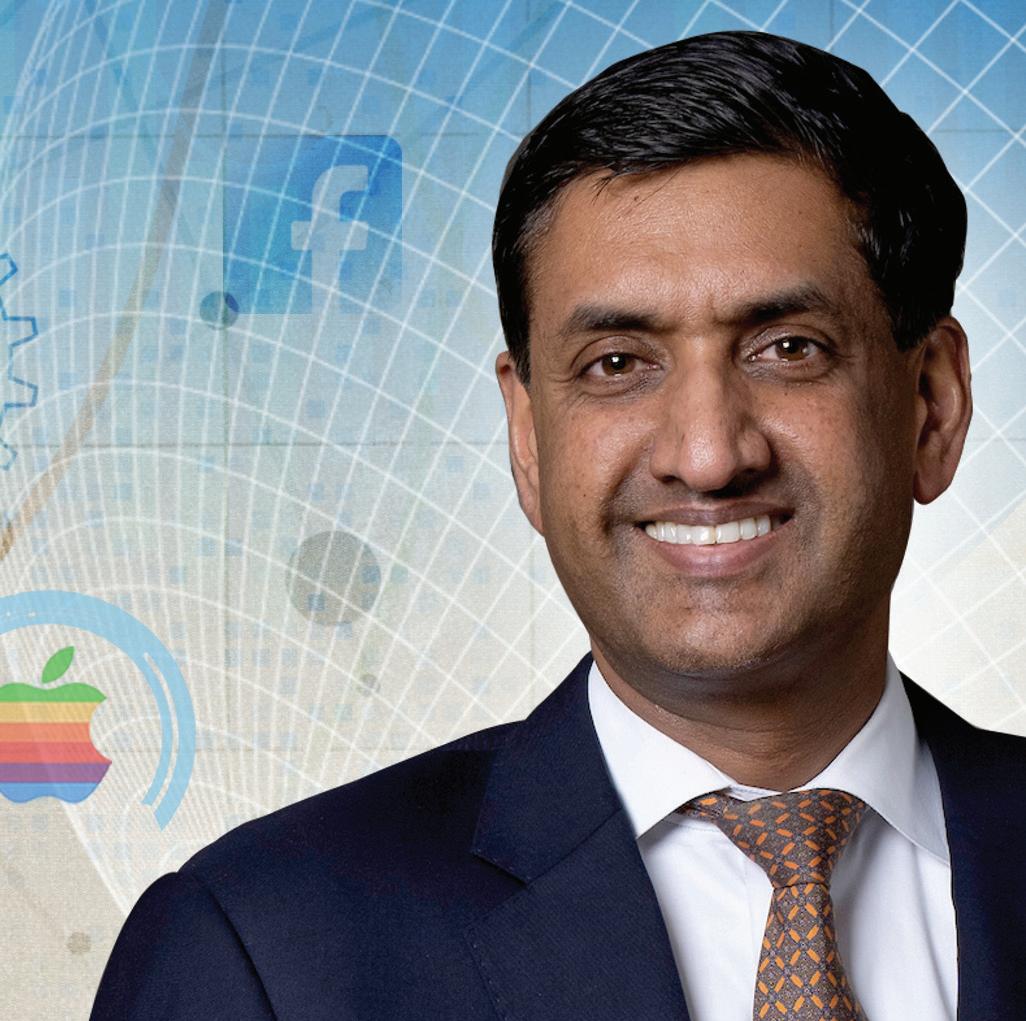

Is There a Lawful and Effective Way?


Reactions to Speta’s Boden Lecture from Bhagwat, Boyden, Goldman, Klonick, Mazzurco, Narechania, Shelanski, and Volokh
ALSO INSIDE
Michael Ariens on Lawyers’ Ethics

Does the Rule of Law Apply in Criminal Appeals?








The Rise of Corporate Landlords







Leadership and Mission at Jesuit Schools Today
When my father taught at St. Ignatius, a Jesuit high school in Chicago, from 1948 to 1950, he was one of the first laypeople on the faculty. By the time I was a student there, a generation later, the high school had changed: Jesuits constituted a distinct minority of its teachers. The trend has continued over the ensuing decades, of course, and a similar scenario has unfolded at other Catholic, Jesuit institutions across the country.
Yet on a number of occasions, an especially great and authoritative St. Ignatius alumnus—Rev. Robert A. Wild, S.J., president of Marquette University for the bulk of the period from 1996 to 2014—has been heard to say that this did not cause him to worry for the mission of these schools. Rather the opposite, he would maintain: Whereas in the bygone days it was natural instinct for laypeople at Marquette University to ascribe “responsibility for the mission” to the many “men in black,” the diminished number of Jesuits on the university’s campus has meant that others, too, have had to embrace the mission for it to thrive. And many others have indeed done so.
At the same time, no one would doubt the importance of presidential leadership. For almost a decade, Father Wild’s successor, Michael R. Lovell, has been the first layperson to serve as president of Marquette University, and the Law School, along with the rest of the university, has benefited from this lay president’s leadership not just generally but, for the topic at hand, with respect to the university’s mission. My purpose here is not to catalog all the ways in which this is true but to give a particular example.
The photo accompanying this column is of President Lovell with
Katie Mertz, director of pro bono and public service at the Law School. This past January, President Lovell honored Director Mertz with a Marquette University “Difference Maker” award. The recognition was focused on her work in leading the Marquette Volunteer Legal Clinics (MVLCs), a quite extraordinary set of community-based operations in Milwaukee in which practicing lawyers and Marquette law students provide brief legal advice to community members trying to find their way through the world generally and legal problems more specifically. The MVLCs make a real difference in this region, and their reliance on partnerships—with local agencies and lawyers—is definitely a page out of President Lovell’s book.
Katie Mertz knows something about Jesuit schools, as a Marquette lawyer herself and as the granddaughter and daughter of
Marquette University graduates in the 1940s and 1970s. It is interesting to note as well that the Marquette Volunteer Legal Clinics got their start, more than 20 years ago, not through employees but rather from the work of Marquette lawyers and students (e.g., Julie J. Darnieder, L’78, and Tanner B. Kilander, then a student and subsequently L’02) and others in the legal profession.
There is, as we often say, an exquisite congruence between the Law School’s undertakings in the legal profession and the mission of Marquette University. No one exemplifies the first of those better than Director Katie Mertz, and no one embodies the second more than President Michael Lovell. The latter’s recognition of the former with a “Difference Maker” award honors and reflects that congruence.
 Joseph D. Kearney Dean and Professor of Law
Joseph D. Kearney Dean and Professor of Law
2 MARQUETTE LAWYER SUMMER 2023
FROM THE DEAN
In January 2023, Marquette University President Michael R. Lovell recognized Katie Mertz, director of pro bono and public service at Marquette Law School, with a “Difference Maker” award. Mertz directs the Marquette Volunteer Legal Clinics, where volunteer attorneys and students serve more than 5,000 people a year at sites around Milwaukee.
Contents
CAN WE GET TO A BETTER INTERNET?
8
Can Common-Carrier Principles Make for a Better Internet?
by James B. Speta
Jim Speta, the Elizabeth Froehling Horner Professor of Law at Northwestern University, uses Marquette Law School’s annual Robert F. Boden Lecture to examine whether legal principles traditionally applied to railroads and telephone companies can help govern an internet dominated by the platforms of a small number of huge corporations.
11
Responses to the Boden Lecture
Eight expert legal academics provide comments on Jim Speta’s proposals. Responses (in order of presentation) from Kate Klonick, Ashutosh Bhagwat, Sari Mazzurco, Eugene Volokh, Howard Shelanski, Tejas N. Narechania, Eric Goldman, and Bruce E. Boyden are interspersed with the text of the Boden Lecture.
30
Seeking Dignity and Connectedness in the Digital World
Congressman Ro Khanna of California has focused substantially on internet issues, including in his 2022 book, Dignity and the Digital Age: MakingTechWork for All of Us. He engages here in a post-Boden Lecture interview with Jim Speta.
2
From the Dean
4
Great Appreciation, Great Anticipation
The Law School salutes two stalwarts who are retiring, Professor Tom Hammer and Associate Dean Bonnie Thomson, and welcomes Judge Derek Mosley as director of the Lubar Center for Public Policy Research and Civic Education and Judge Mary Triggiano as leader of the Andrew Center for Restorative Justice.

34
Acting in the Best Interests of Client and “King”
In a new book, Michael S. Ariens, L’82, considers the duties and obligations of lawyers past and present. The book occasions this feature, which includes reflections from three current Marquette Law School faculty members—Peter K. Rofes, Rebecca K. Blemberg, and Nathaniel Romano, S.J.—and a pertinent excerpt of a 1982 law review article by Robert F. Boden, then dean of the Law School.
44
Unretiring Thoughts from a Retiring Criminal Defense Lawyer
Ellen Henak says that trends in the justice system raise doubts about the rule of law
48
The Rise and Impact of Corporate Landlords

John D. Johnson, research fellow at Marquette Law School’s Lubar Center for Public Policy Research and Civic Education, describes how big investors are buying up low-cost houses in Milwaukee.
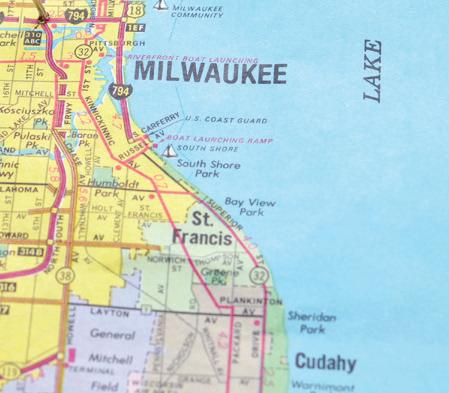
55
Class Notes
Marquette University Law School
Eckstein Hall
P.O. Box 1881
Milwaukee, Wisconsin 53201-1881
Phone: (414) 288-7090
law.marquette.edu
EDITOR: Alan J. Borsuk
DESIGN: Kristin Pelisek
COPY EDITOR: Amy Bauman
PHOTOS: James Kegley Mike Gryniewicz Gary Porter University Archives
Copyright 2023 Marquette University. All rights reserved.
3 SUMMER 2023 MARQUETTE LAWYER
SUMMER 2023
34
44 48
The Great Voyage of the Hammership
It’s one thing to be successful in building an academic program. It’s another to be so successful that your name becomes associated with it. In no other law school would the word Hammership mean anything. For Marquette Law School students across many years, the name needs no explanation; for others, the meaning may be given as “an internship program that has been a highlight of the Marquette Law School education for many hundreds of students, helping open paths for many to legal careers in the fields they most desired.”
Thomas J. Hammer, L’75, joined the Law School’s full-time faculty in 1981, reluctantly giving up a job he prized as an assistant district attorney for Milwaukee County. Since then, in more than four decades on the faculty, he taught courses such as Criminal Law and Criminal Procedure and played important roles in charting Wisconsin policy on those subjects. But he is best known in Law School circles for an assignment he
took up from the late Dean Howard B. Eisenberg in 2001. Eisenberg asked Hammer not just to lead the internship program that gave students work experience in legal practice but to expand it by increasing the number of internships offered and students enrolled each semester. At the time, placements were quite limited in number, and the volume of student applications for internships was small and in decline.
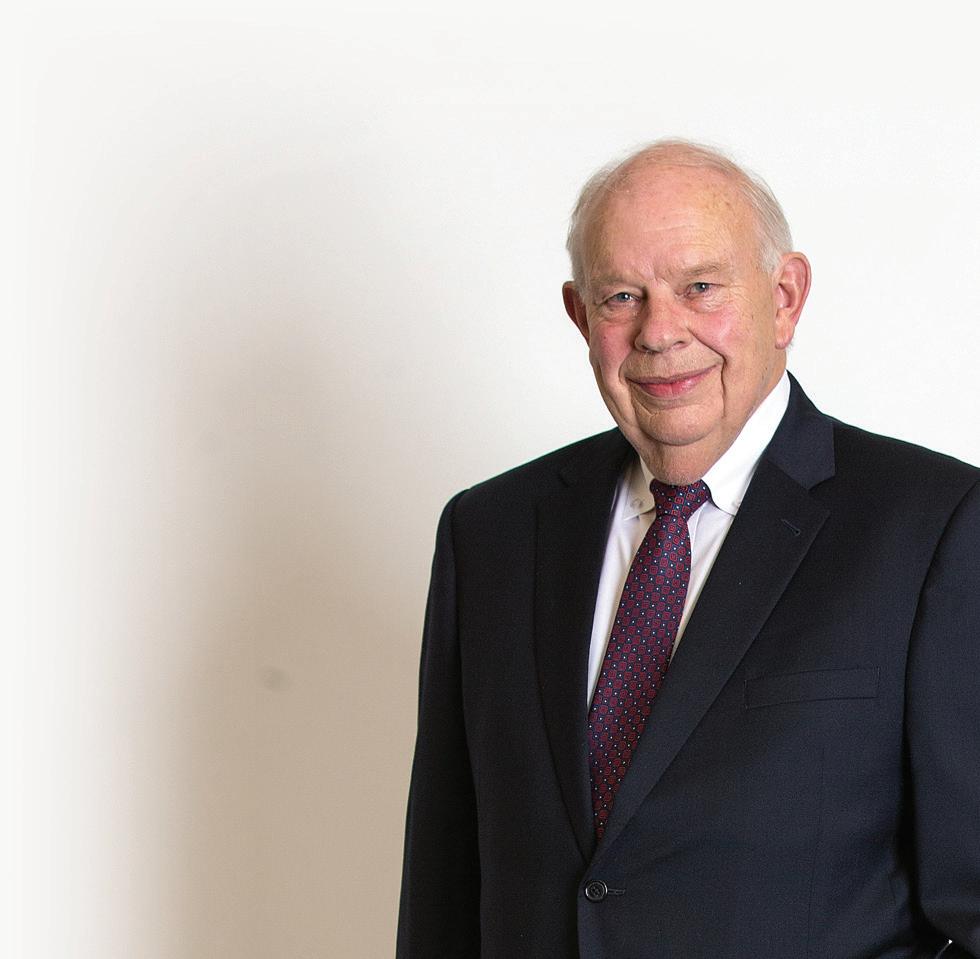
While maintaining his classroom role, Hammer threw himself into the assignment. Internships with a range of nonprofit organizations and government agencies were added. Hammer wanted to see that “no matter what a student might be interested in, there would be an opportunity to have an internship.” To an impressive degree, he succeeded.




There are now more than 50 internship programs, and 90 to 100 students (approximately one-quarter of the upper-level law school enrollment) are involved in internships each semester. Among graduates in 2022, for example, 75 percent did at least one internship, and many did several, Hammer said.
Early on, students began calling the placements “Hammerships.” Of the eponym, Hammer said, “For quite some time I was unaware of this.”
Students receive academic credit for the supervised internships. They develop not only pure legal skills but also ways to deal with clients and
4 MARQUETTE LAWYER SUMMER 2023
Comings and goings are always a major matter at a school.
Yet two retirements and two appointments at Marquette Law School during the first half of 2023 merit particular attention.
Consider the four short profile stories that follow as thank-you cards to two pillars of the Law School and warm welcomes to two people who we anticipate will help build the school even further.
Great Appreciation . . .
colleagues—a host of things that make them more “practice-ready” when they graduate, something employers want, Hammer said.

All of this is separate from the Law School’s large pro bono program, in which a majority of students do volunteer legal work in many public service settings. Together, the internships and the pro bono programs show the large-scale commitment among Marquette law students to serving the public.
At the start of the Spring 2023 semester, Hammer told students, “The Hammership is sailing for the last time.” Hammer assumed emeritus status at the end of the semester.
Anne Berleman Kearney, an adjunct professor at the Law School since 1999 with extensive litigation experience in the region, has been named to succeed Hammer as director of clinical education. The ship will sail forward, a larger and more impressive vehicle as a result of Hammer’s years at the helm.

Bonnie Thomson: The Utility Infielder Who’s an MVP
Bonnie Thomson holds up two pieces of paper. One is a weekly schedule of Marquette University Law School classes from a semester in the 1970s. There’s quite a bit of white space on the page. The other is the weekly schedule of classes for the Spring 2023 semester. The page is full of entries—in small type on both sides.
A lot has changed since Thomson joined the Law School staff in 1985. She was hired as placement director to help students navigate the job market after graduation. For the past 25 years, her title has been associate dean for administration and registrar. What has that meant? For starters, she has overseen class schedules, exam schedules, room assignments,
and a host of other “academic logistics.” More generally, it meant she has been nearly indispensable. For many faculty members and students, the answer to all sorts of questions was: Ask Dean Thomson. She described her role as “utility infielder.”

Beyond her listed duties, she was an advisor and confidant for innumerable students and staff, a big help with everything from navigating academic challenges to handling personal crises to advising on how to train dogs (especially her favorites, German shepherds—“I can’t imagine life without a dog,” she said). Thomson also has been the go-to-person for any student who wants to talk about University of Michigan football. “Go Blue,” she said.
How has the Law School changed over her 38 years? Thomson gave a few answers: The curriculum is much deeper, students have more electives and academic paths to consider, pro bono efforts have burgeoned, and the public profile of the Law School has grown, thanks largely to public policy and pro bono programs.
As Thomson retires, she is confident that she won’t be missed. Many of her duties will run to Jessica (Bacalzo) Fredrickson, L’99, newly appointed as the Law School’s registrar and director of curricular services. Yet it is plain to all familiar with the Law School that it will require teamwork to help replace Thomson when she retires this summer. As Dean Joseph D. Kearney said in a letter to students at the start of the Spring 2023 semester, “Truly, this will be the end of an era. . . To say that Associate Dean Thomson has been the glue holding the Law School together even longer than the going-on twenty years of my deanship begins to get at the matter.”
Thomson said, “I can’t imagine a better 38 years. It has just been such a gift.” She added, “I love the students. I just love the students.”
5 SUMMER 2023 MARQUETTE LAWYER
. . . and Great Anticipation
The Mosley Goal: Connecting People with One Another
Near the end of an “On the Issues” program in March 2023 in Marquette Law School’s Lubar Center, Derek Mosley was asked what gives him hope and what keeps him up at night.
“I’ll tell you what gives me hope,” answered Mosley, who began in January as director of the school’s Lubar Center for Public Policy Research and Civic Education. “When I walk into this building every day, that gives me hope.” He sees young people who want to make a difference and make the world better. “I hear these conversations, and that gives me hope.”
“What keeps me up at night is that we’re going to continue on this trajectory where we don’t talk to each other—where we’re going to just silo ourselves so much that we don’t communicate enough to solve even the most simple problems we have.”
Mosley, L’95, was already a wellknown figure, in the Milwaukee region and beyond, before taking the Lubar Center position. He was a citywideelected Milwaukee municipal judge for 20 years, a frequent speaker on Black history and related subjects, a prominent “foodie” with a large presence on social media, a member of numerous nonprofit boards of directors, and an outgoing personality who knows tons of people.
Mosley said that he served long enough as a municipal judge to see defendants come before him who were grandchildren of people whose cases he had judged years before. It was disheartening, and, as much as he tried to be constructive, he could deal with cases only one at a time.


He hopes to have a bigger reach in the Lubar Center position, creating and leading programs that “put people into situations where we talk to each other.” He expects to lead the Law School in continuing the “On the Issues” programs that were built up so successfully over 15 years by Mike Gousha, the Law School’s distinguished fellow in law and public policy (and, since January 2022, the school’s senior advisor in law and public policy). In addition, Mosley wants to host more informal “Get to Know” programs with significant or interesting community figures, and he wants to convene events such as the “narrative tasting” in February (Black History Month) that drew more than 200 people to a program on popular American foods that were originated by Black cooks and chefs. At that program, people were intentionally seated with others whom they didn’t know previously.
Mosley wants to engage with community groups that are addressing community needs as he looks to bring people together in a wide range of ways. “This opportunity gives me so many options,” he said.
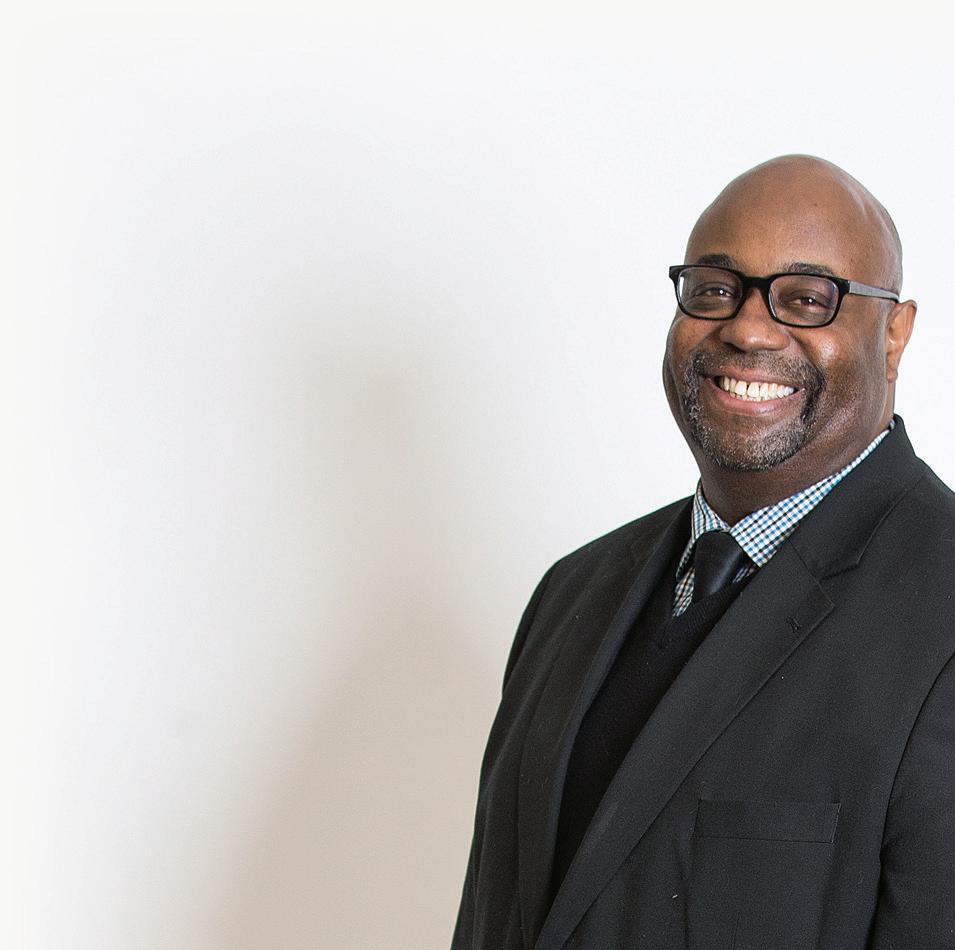
6 MARQUETTE LAWYER SUMMER 2023
Mary Triggiano Tackles New Building Projects
Mary Triggiano’s father was a carpenter. She said he wondered sometimes what she did as a judge.
“I build things, Dad,” she told him. They weren’t made of wood, but they were important and had impact on people and institutions.
As a Milwaukee County Circuit Court judge since 2004 and as chief judge since 2020, Triggiano played leading roles in building a lot of things, including problem-solving courts, programs promoting awareness of the impact of trauma on people who came to court and people who worked in the court system, and solutions to complex administrative problems facing the court system.
Triggiano became chief judge a month before the COVID-19 pandemic hit with full force in March 2020. So she quickly had to design and lead the fast-track construction of ways to conduct court proceedings virtually. Then came building ways to return, over the course of two years, to inperson court operations, with tools including substantial federal aid to recover from backlogged proceedings and other problems.

Now Triggiano is taking on a new challenge: Building on the legacy of Janine Geske, L’75, as leader of the restorative justice program at Marquette Law School. Geske, a former
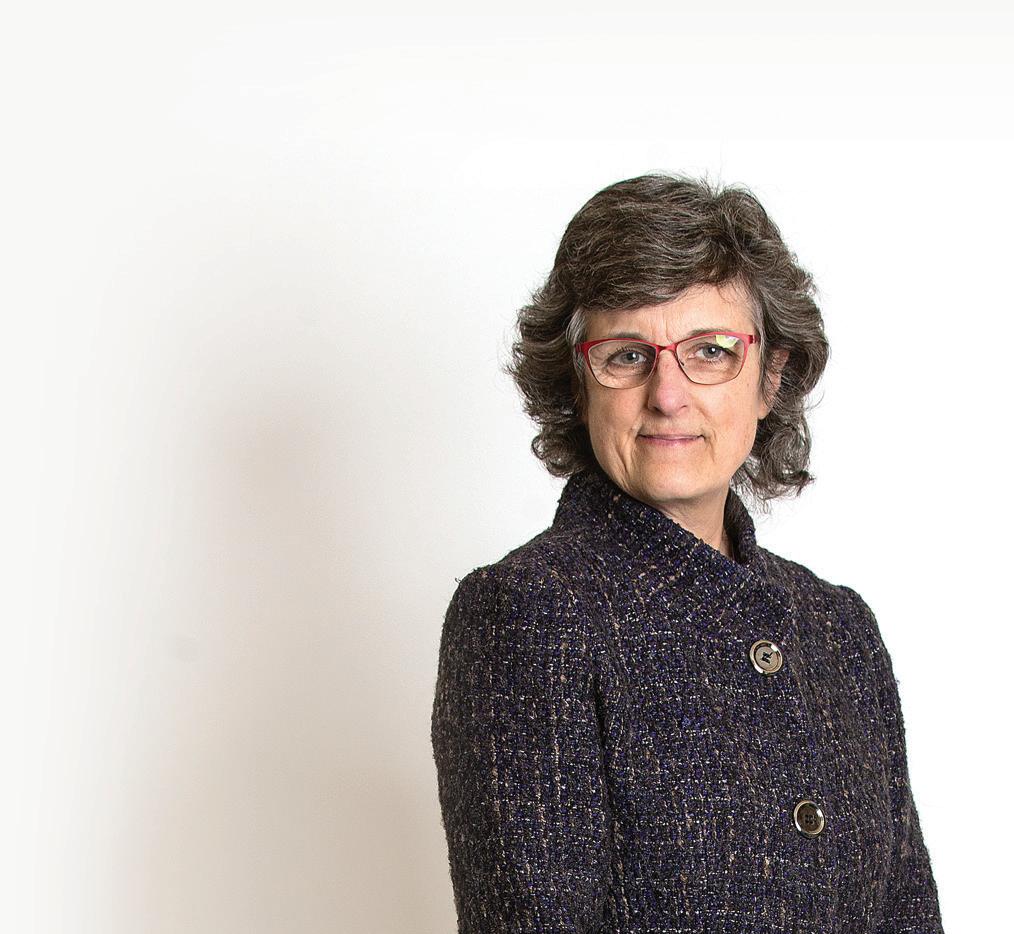
justice of the Wisconsin Supreme Court and a faculty member at the Law School, led the establishment in 2004 of the school’s Restorative Justice Initiative, which seeks to help victims and communities heal and move forward.

In 2022, thanks to a $5 million gift to the Law School from Louis and Suzanne Andrew, Geske returned temporarily from “retirement” to lead the launch of the school’s Andrew Center for Restorative Justice and to help find her successor. Geske said she was “beyond thrilled” at the appointment of Triggiano. The latter traces her own involvement in restorative justice work to her experiences in programs Geske led at Green Bay Correctional Facility.
Triggiano wants to continue Geske’s work while building on ideas of her own, including ways to expand efforts in children’s courts and at the Milwaukee County Community Reintegration Center (formerly the House of Correction). She also wants to get more Marquette University faculty and students involved in restorative justice. In short, she wants the Andrew Center to be one of the premier centers anywhere for work of this kind.
“We have a great foundation, and I’ve got all sorts of ideas,” Triggiano said.

Triggiano’s father died in 2015. But one imagines he would be impressed by her building accomplishments and plans.

7 SUMMER 2023 MARQUETTE LAWYER

THE PAST’S LESSONS FOR TODAY:
CAN COMMON-CARRIER PRINCIPLES MAKE FOR A BETTER INTERNET?
 BY JAMES B. SPETA
BY JAMES B. SPETA
Let me begin by saying that I’m grateful to Marquette Law School for the invitation to deliver the Robert F. Boden Lecture and to everyone who has made this experience possible. I’m honored to speak in this series, which has featured so many leading academics. And I feel connected to it, at least in the sense that I understand one of Dean Boden’s distinguishing characteristics to have been his commitment to practical education—to the insistence that a law school’s exploration of theory must serve the profession and prepare students for the practice.
I come to legal academia as a practicing lawyer, and here is the most important way in which Dean Joseph Kearney’s invitation is so meaningful: I had the great privilege to learn lawyering with and alongside him, in the early to mid-1990s, and I’ve marveled at his and Marquette’s successes during his long deanship and at the commitment to educating new lawyers—Marquette lawyers, as I know you say around here. He is also, as I’m sure you know, simply one of the most wellrespected and admired deans across the American legal academy.

Legend has it (and this has some support from the Marquette Lawyer magazine) that, a few years ago, a Boden lecturer—now the dean of Yale Law School no less—was instructed to speak for precisely 43 minutes. Whether I meet that precise mark, we hope to have time remaining in our hour to open the floor to questions and discussion. The matters at hand are very current and very important.
Jim Speta is the Elizabeth Froehling Horner Professor at Northwestern University Pritzker School of Law. In September 2022, he delivered Marquette Law School’s annual Robert F. Boden Lecture. The following is a lightly edited version of that lecture, interspersed with brief responses from various legal academics. The feature concludes with a question-and-answer session between Speta and Congressman Ro Khanna (of California), who himself has written extensively with respect to internet law and policy.
Illustrations by Stephanie Dalton Cowan
INTRODUCTION
My subject for today is the dominance of the internet platforms and, together with that, various proposals that would regulate the content and viewpoint of those platforms. Indeed, the currency of our topic was emphasized just this past Friday (September 16, 2022), when a Fifth Circuit panel upheld a Texas state law which imposed commoncarrier requirements on the largest internet platforms. The court found this consistent with the First Amendment. This had been the first statute of its kind, and this was the first decision upholding such regulation. Earlier this year, the Eleventh Circuit reached exactly the opposite conclusion involving a nearly identical Florida statute—holding that statute unconstitutional. (Both cases have NetChoice, LLC, as the lead plaintiff, so I shall refer to them by circuits rather than by names.)
These statutes and the broader policy debate raise central questions about the speech ecosystem that we now have in this country and the ecosystem we would like to create. In this lecture, I will address both the dominance of the internet platforms and the calls to regulate those platforms as common carriers.
To begin to define our terms: this reference to the platforms means the dominance by Google and Facebook, by Amazon and Apple (and to a lesser extent by Twitter and Microsoft), over the ways we receive information, exchange it, even understand it. The main concern is that these platforms are biased, that they discriminate, that they foreclose speech.
That is why, today, platform critics—including governments—are reaching for the traditional law of railroads and of telephone companies: the law of common carriage. That once-dominant law forbade discrimination. In addition to the Texas and Florida statutes—again, one so far upheld and one struck down—a Supreme Court justice has written in favor of platform-focused common-carrier regulation, as have numerous federal and state lawmakers, some academics, and many commentators. Bills have been offered or are pending in Congress and in many states, including here in Wisconsin.
The proposals for common-carrier regulation of platforms seem to me very right—and very wrong. They are right to worry about the dominance of internet platforms. And they are right that commoncarrier law—even though it smells musty and has largely been discarded in the United States over the past few decades—can be part of the solution.
Yet I think the proposals are very wrong to target common-carrier solutions at the platforms’ core operations themselves—to change the ways in which users are permitted access, content is moderated, and search results are provided. Such platform regulation does not fit the common-carrier model. Platforms are not merely conduits of user behavior, although they are partly that.
Platforms also seek to create a particular kind of speech experience that holds the attention of their users. If we are required to have an analogy to an old form of media, platforms are more like newspapers and broadcasters than telephone companies, although I think the best single analogy is to bookstores. Newspapers, broadcasters, and bookstores curate the content they offer their customers, and common-carrier rules have never applied to them. Even more concerning, laws directly controlling platforms simply give the government unprecedented power over the content experiences these private companies seek to create. I think that this violates the First Amendment and that the Fifth Circuit’s decision to the contrary is quite wrong.
Here’s what we can do instead: we can and should at least try to address concerns about the currently dominant platforms by using law to make it easier to have more platforms. This, truly, is my essential argument: Common-carrier solutions should be targeted at the infrastructure that enables platforms to be built and to reach consumers.
When we think about platforms, we usually think about the ways that users interact directly with Google or Twitter or other services. But, in fact, myriad companies provide infrastructure and services that enable user access or platform operation—companies that transmit data, such as the cable companies and other internet service providers carrying data; companies that host websites and platforms; and companies that provide services such as website defense or payment processing to support both new and established platforms. For ease of exposition, I have prepared a single Figure (see page 13): a simplified graphic showing all the companies that stand between platform users—you and me—and the platforms themselves. In the past, some of these providers have denied services to various new platforms that sought to establish alternative services.
Applying a lighter-touch (and differently placed) version of common-carrier regulation to the
A BETTER INTERNET
The main concern is that these platforms are biased, that they discriminate, that they foreclose speech.
10 MARQUETTE LAWYER SUMMER 2023 continued on page 13
That is why, today, platform critics— including governments— are reaching for the traditional law of railroads and of telephone companies: the law of common carriage.
SPEECH PLATFORMS—THE MANY-TO-MANY BROADCAST MODEL
by Kate Klonick
I’m honored to be asked to comment on Professor James Speta’s exceptional Boden Lecture, but my task is made more difficult by the fact that I agree with almost all of his conclusions. We apparently share a similar streak of moderation and pragmatism, which does not bode well for a rigorous reply, but I will do my best.
The law and history of common carriage are complicated, and various internet controversies over the last 20 years have seen it thrown into the fray as a panacea or Hail Mary pass. In my experience in interdisciplinary conversations about online speech platforms, the idea of treating platforms as common carriers is usually raised in the eleventh hour of discussion—usually by someone tentatively asking, “Have you thought about treating platforms as railroads?”
It sounds initially absurd, but there’s good reason that this concept has strong intuitive appeal: it involves nondiscrimination in the provision of essential services— and at a superficial level “essential services” certainly feels like our relationship with the shiny glass boxes and speech platforms on which we spend 55 percent of our waking hours. And it’s hard to disagree that those platforms’ decisions—of what content we can and can’t see and whom we should and shouldn’t hear from—have echoes in nondiscrimination.
But, of course, as Professor Speta so accurately points out, the legal and technological history and rationales of the common-carrier concept do much to limit its practical use as a solution to the problems presented by speech platforms.
Besides his point about the differences in rationale (the limited physical spectrum of radio and television, or the economies of scale of infrastructure), there was one part of Professor Speta’s lecture that particularly spoke to me: the difference in the editorial function of broadcast and telecom companies from online speech platforms. As Speta so astutely points out, television and radio broadcast companies create and disseminate commercial content created by a private few to the public many. By contrast, telecommunications firms do
not themselves create any content or even engage with it; they merely facilitate one-toone (or few-to-few) communications between members of the public. In contrast with both broadcast and telecom examples, user-generated online speech platforms instead disseminate content created by the many to the many
The important distinguishing feature here is the first side of the many to many—that is, the many speakers to many listeners. Never in history have so many speakers been given so many open points of access not only to speak but, more importantly, to so widely broadcast. It is truly what makes online platforms unique—and what any historical analogy necessarily fails to capture.
The essential function of speech platforms is the one way in which Professor Speta’s very resonant comparison of online speech platforms to bookstores fails, because of course physical bookstores, as we have known them for most of history, are also subject to the limited physical spectrum of space; cuts must be made about what will be promoted or sold at all. This pressure fundamentally forces a bookstore to be a gatekeeping content provider—a few-to-many platform. And although online speech platforms certainly also promote, or curate, select content for certain products and functions (like newsfeeds or timelines), the majority of speech remains available and accessible by index or search, even if not amplified or delivered by algorithm.
In so many ways, the questions invoked by these new technologies are age old, but in other ways so dramatically different from anything we have encountered as a society before. I am so grateful for the intellectual conversation that Professor Speta’s remarks have advanced, and to be a part of a community that continues to think curiously, creatively, and systemically about the nature of the problem and how to solve it.
Kate Klonick is associate professor of law at St. John’s University, an affiliate fellow at the Information Society Project at Yale Law School, and a nonresident fellow at the Brookings Institution.

11 SUMMER 2023 MARQUETTE LAWYER
RESPONSE
TECHNOLOGY, ANALOGIES, AND LEGAL REASONING
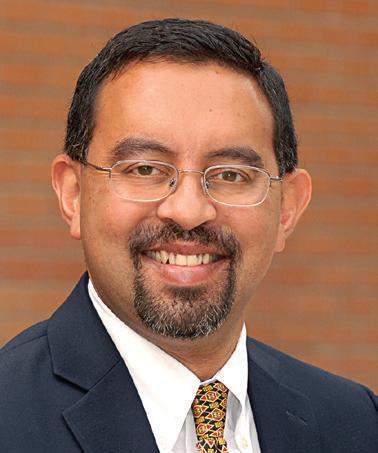 by Ashutosh Bhagwat
by Ashutosh Bhagwat
Thank you to Professor Speta for this fascinating lecture and to Dean Kearney for the opportunity to provide a brief commentary. I should begin by acknowledging that I agree with Professor Speta’s main argument in almost every respect. Perhaps that is unsurprising, since I too learned and practiced telecommunications lawyering with Dean Kearney (and Professor Speta) a long time ago, in a galaxy far, far away. I completely agree that the common-carrier label is a profoundly bad fit for social media and search platforms; indeed, I argue the same in a recently published article in The Journal of Free Speech Law. I also agree that where common carriage, or more accurately a nondiscrimination requirement, makes more sense is with respect to internet infrastructure.
There is, however, an aspect of Professor Speta’s argument that raises very difficult questions for me. He argues that “the best single analogy” between platforms and a traditional medium is bookstores. Like bookstores, platforms distribute content generated by third parties rather than by themselves, and, like bookstores, platforms necessarily curate that content, choosing what content to carry, what not to carry, and what to emphasize. All of this is clearly correct, as is Professor Speta’s ultimate conclusion that just as bookstores enjoy First Amendment rights regarding their curation decisions, so too should platforms. And therefore the Fifth Circuit’s contrary conclusion—that because platforms are not “speakers” in their curator or content moderator roles, they do not have First Amendment rights—is clearly incorrect.
Bookstores probably are the best traditional-media analogue to modern platforms. And as lawyers, we are inevitably drawn to analogies. This analogy, however, is deeply imperfect for several reasons (and I doubt Professor Speta would disagree). First, bookstores do not possess network effects, as social media platforms do. There is no benefit to shopping at the same bookstore as your friends—to the contrary, if you want to get a reputation as a savvy gift-giver or an iconoclastic thinker, the motivation is precisely the opposite. But with social media, the entire value derives from using the same platform as your friends. Second, while bookstores sell third-party content, it is (unlike social media) not user-generated content. Finally, the sheer volume of content that all platforms process is incomparably greater than any bookstore on Earth.
According to recent statistics, Facebook has almost two billion daily active users. Powell’s Book Store is a minnow in comparison. These differences matter for two reasons. First, the scale and network effects associated with at least social media platforms make Professor Speta’s (and my) dream of real competition among such platforms elusive (search platforms are a different story). Certainly, small platforms for politically obsessed fringe groups may survive, but for those of us for whom social media is, well, more social, we want to be where “normal” people hang out online, rather than on Gab or Parler. Second, the combination of user-generated content and sheer volume means that the kinds of personal curation decisions characteristic of bookstores are impossible on platforms. As a result, when one discusses regulating content moderation—and the converse issue, the extent to which content moderation enjoys First Amendment protection—one must face the fact that with platforms we are talking about algorithms and artificial intelligence, not your friendly neighborhood bookstore owner. The questions about the extent to which algorithms and AI should be regulated or constitutionally protected are very different from whether bookstores enjoy First Amendment rights.
So does this mean the analogy to bookstores is useless? No, analogies provide useful guidance. But it does mean that as we apply the law to wholly new technologies, with no perfect pre-internet analogues, we as lawyers need to be wary of relying too much on analogies and turn instead to first principles. Do I believe platforms should have First Amendment protection against overweening regulation? Absolutely, but not mainly because they are the same as bookstores. It is rather because protecting platform independence from self-serving political actors advances the underlying, democracy-enhancing purposes of the First Amendment. But that is a longer discussion.
12 MARQUETTE LAWYER SUMMER 2023
Ashutosh Bhagwat is Distinguished Professor of Law and the Boochever and Bird Endowed Chair for the Study and Teaching of Freedom and Equality at the University of California, Davis.
RESPONSE
internet’s support providers, I will seek to convince you, can increase the possibility of alternative platforms. This is our best hope to enrich our speech choices and ecosystem without government censorship. At the end of the day, I contend that my proposal—considered comparatively—has the advantages of parsimony and modesty. Government should not intervene in the speech ecosystem any more than is absolutely required to meet an important governmental interest.
I do think that the Fifth Circuit decision is, well, just wrong and that, in fact, the Texas statute and similar proposals violate the First Amendment. Yet I need not convince you of that point of constitutional law. I need only persuade you that a more limited regulation—more limited in that it involves less direct government control over the creation of content experiences, of speech experiences—can address the problem.
Let me do so in three main moves. First, I’ll provide a little background on platform dominance and the current proposals for common-carrier regulation. Second, I’ll argue that common-carrier duties—particularly access requirements and nondiscrimination rules, which are the core of common carriage—both don’t fit platforms and also give the government too much control over speech. And, third, I’ll propose that commoncarrier rules, especially access rules (which are really just a light form of nondiscrimination), when applied to internet service providers (ISPs, such as Comcast and AT&T), to hosts, to security support, and perhaps even to intermediaries like app stores, could increase the diversity and availability of platforms. We have in fact seen these sorts of companies deny access to alternative platforms, and those denials have been consequential.
Then, at the end, I will grapple with two problems. Can we write a rule that is administrable and meets the objections to common carriage for platforms? And will a fracturing of dominant platforms, even if it makes more speech available, actually create more problems for democracy, good policy making, and civil discourse?
I come to this very modern topic of internet platforms based on many years of writing about common carriage and asking how it applies both to the internet and perhaps to other modern industries. As I hope I have already indicated, these are hard, hard questions, and reasonable people can differ.

But I am certain about a few things—that this is a debate worth having, that common-carrier rules

A BETTER INTERNET
13
I need only persuade you that a more limited regulation— more limited in that it involves less direct government control over the creation of content experiences, of speech experiences— can address the problem.
ISPs
At least half of the ten most valuable companies in the world are internet platforms, and that number used to be higher before the beating tech stocks have recently taken in the market.
can help us think about internet platforms, and that applying such rules to the internet platforms’ support layers could increase the diversity of platforms.
DOMINANT PLATFORMS AND DISCRIMINATION
I don’t suppose it should take much of my time to say that we live in an era in which certain internet platforms hold enormous sway—over speech, entertainment, and commerce. At least half of the ten most valuable companies in the world are internet platforms, and that number used to be higher before the beating tech stocks have recently taken in the market.
Dimensions of Platform Power
Google has almost two-thirds of all searches in the United States and more than 90 percent of all searches in every country in the European Union. Google also provides the operating system on some 75 percent of the world’s cell phones and the browser on just under two-thirds of all computers and phones. Amazon has more than 40 percent of all U.S. online commerce. Facebook, together with its subsidiaries Instagram and WhatsApp, dominates traditional social networking, and Twitter has become a key source of information, debate, and
entertainment. In the United States in particular, Apple, too, is a key platform, through its App Store and its phones.
If anything, these numbers play down the importance of these platforms in traditional media functions such as news. About one-third of all U.S. adults say that Facebook is a regular news source, and very nearly 50 percent of Americans “often” or “sometimes” get their news from social media. In 2017, the Supreme Court itself, in striking down a law that limited individuals’ access to social media, identified social media as our “modern public square.” It elaborated that such a law as the one challenged there “bars access to what for many are the principal sources for knowing current events, checking ads for employment, speaking and listening in the modern public square, and otherwise exploring the vast realms of human thought and knowledge.”
I do not necessarily mean that these platforms have “market power” in a traditional antitrust sense (although the U.S. Justice Department and most of the states have filed lawsuits saying that at least the biggest platforms do). I concede, for one example, that “search” is not a single economic market and, for another, that Google, Facebook, and Twitter are actually direct competitors in the advertising market. One of the most important truths of media and communications law is that when the
continued on page 17

14 MARQUETTE LAWYER SUMMER 2023
RESPONSE
INTERNET INTERMEDIARY “MUST CARRY” RULES
 by Sari Mazzurco
by Sari Mazzurco
Professor Jim Speta’s Boden Lecture identifies a problem of tremendous complexity with great tact and acuity: how can law help create an online speech ecosystem that enables more speech while minimizing government control over the “content experiences” that entities such as Facebook and Google produce? He proposes that common-carriage regulation has a part to play but should not be directed at the likes of Facebook and Google. Rather, he says, it should be aimed at the myriad intermediaries that operate in the background to connect these entities to the eyeballs of real, live human internet users. These internet intermediaries include internet service providers (ISPs), hosts, and security providers, which transact with social media companies and have some power to enable or restrict these companies’ entry to the internet.
Indeed, Professor Speta identifies these intermediaries’ power over entry as the foundational problem. He asserts that if this power is restricted—through requirements to “grant access and services to new platforms and services on the same terms” they provide to others—new social media companies will crop up to fill gaps left by incumbents. Parler, Gab, and potentially more liberal-leaning social media companies would join ranks with the incumbents to provide internet users a social media smorgasbord—more access to speech and opportunities to speak through greater selection among alternatives.
Although Professor Speta regards his proposed requirements as common carriage of a “light-touch sort,” they call to my mind a different form of regulation—the “must carry” rules of the Federal Communications Commission (FCC). Historically, “must carry” rules allowed local television stations to require a cable operator serving the same market to carry their signals. FCC “must carry” rules shed light on the political magnitude of Professor Speta’s compelling proposal and might help defend it against First Amendment objection.
The FCC promulgated “must carry” rules to solve a bottleneck problem as cable companies came to intermediate viewers’ access to television programming; this is much like the problem Professor Speta calls out on today’s internet. Carrying smaller and less popular broadcast networks was not profitable for cable companies, but it was the difference between life and death for those smaller networks. The FCC deemed saving these smaller networks valuable because it would serve the public interest in media diversity and access to information—the two values Professor Speta asserts his “common-carriage inspired” proposal would serve. It made sense for the FCC to pursue these values because of its particular construction of the public as
“listeners” in a democracy. The gist of it: as “listeners,” people need access to a wide range of diverse viewpoints so that they can be effective participants in democratic government. A biased or sparse media ecosystem is thus a significant political problem. Regulation that prioritizes the survival of small broadcast networks over a cable company’s bottom line serves that end. When applied to internet intermediaries, social media companies, and internet users, a cable–broadcaster–listener role-framing may provide a robust defense against a First Amendment objection to Professor Speta’s proposal. In fact, it turns such an objection on its head. Much as the Supreme Court held in Turner Broadcasting System, Inc. v. FCC (Turner II) in 1997, restricting internet intermediaries’ freedom to refuse to deal with new social media companies might instead serve important First Amendment values.
Common-carriage regulation, by contrast, minimizes the democratic importance of public access to multiple social media companies. It construes social media companies as “passengers” (or, potentially, “subscribers”) of internet intermediaries’ services (the “common carriers”) with an interest in participating in the internet market. To be sure, it guards against the risk that internet intermediaries might act unfairly by excluding social media companies from the market, but internet users’ role and interests are conspicuously absent. The harm of an insufficiently populated media ecosystem is economic, personal, and individual to the particular excluded social media company. Democratic harm is foreign to this relationship construction. Moreover, “nondiscrimination” requirements are especially vulnerable to First Amendment attack. 303 Creative LLC v. Elenis has presented the Supreme Court with the question whether Colorado’s Antidiscrimination Act “compels speech” in violation of the First Amendment.
Professor Speta makes a forceful case that regulation of internet intermediaries is a crucial step toward a diverse, participatory online speech ecosystem. But appealing to common-carriage regulation may not be the best fit to achieve that end. FCC “must carry” rules, and the FCC’s construction of the triadic cable–broadcaster–listener relationship, add helpful context on the political basis and implications of Professor Speta’s proposal and might better shield it from the deregulatory First Amendment.
15 SUMMER 2023 MARQUETTE LAWYER
Sari Mazzurco is an assistant professor of law at SMU Dedman School of Law.
RESPONSE
DOES THE FIRST AMENDMENT PROHIBIT ALL PLATFORM REGULATION?
by Eugene Volokh
Professor Speta and I agree on much. We agree, for instance, that search engines can’t be treated as common carriers: If you Google “theory of gravity,” you presumably want the top results to represent mainstream viewpoints about gravity, rather than rival viewpoints.* Likewise, when social media platforms recommend sites to you, they should be free to recommend what they think is worth viewing, based on their guesses about your preferences and their own judgment.
But when it comes to hosting—for instance, letting Donald Trump have a Twitter account, and letting his followers re-Tweet his posts to their followers—a viewpoint-neutrality rule is more plausible. I’m not sure it’s wise, but it should be seriously considered. And I don’t think it’s unconstitutional.
The First Amendment does forbid the government from discriminating based on viewpoint, and usually based on content as well, as Speta notes. But I don’t think that this stops the government from forbidding viewpoint discrimination by certain private parties.
(The Fourteenth Amendment bars the government from discriminating based on race and sex, and that’s seen as consistent with statutes that apply similar rules to many private parties.)
Nor are such neutrality mandates invalidated because the drafters are motivated by a concern that platforms are suppressing particular viewpoints. Most antidiscrimination laws, in fact, are triggered by a concern about some particular group being harmed; yet they can protect all groups against discrimination. Likewise, the viewpoint-neutrality requirements would protect all viewpoints, Left, Right, or other.
What about platforms’ interest in creating their “preferred speech experience,” as Speta terms it? Platforms do have a right to decide what material to specially promote to their users. They should also probably remain free to edit third-party comments
* I have argued this in a white paper commissioned by Google, Eugene Volokh & Donald M. Falk, First Amendment Protection for Search Engine Search Results, 8 J.L. Econ. & Pol’y 883 (2012), but I would also endorse this view as an academic.
posted on someone’s page or attached to someone’s Tweets, both to stop spam and to block insults that tend to degrade the quality of user conversations— though that “conversation management” function is a complicated matter. But it doesn’t follow that platforms have a First Amendment right to block users, based on viewpoint, from speaking to willing listeners. In Rumsfeld v. FAIR (2006), for instance, universities sought to create a “preferred speech experience” by excluding military recruiters from recruiting on campus, because the military discriminated against gays and lesbians. Universities had ideological reasons for doing this, and many of their constituents (faculty, students, donors) were upset by military recruiters’ presence on campus. What’s more, universities are quintessential speakers, routinely speaking on their own property. Doesn’t matter, said the Supreme Court: Congress had the power to mandate that universities include military recruiters on the same footing as other recruiters.
Likewise, a few states, including California, mandate that large shopping malls allow leafleters and signature gatherers on the premises. The shopping malls may want to create a “preferred speech experience” that consists solely of the mall’s and its tenants’ advertising, and not have customers put off by political messages that might offend them, anger them, or just distract them from buying. But in PruneYard Shopping Center v. Robins (1980), the Supreme Court held that a state could nonetheless compel shopping malls to allow such outside speakers.
The Court has told us, in 2017, that social media is “the modern public square.” The First Amendment mandates that all viewpoints be allowed in the old, traditional public square. It likewise doesn’t bar all government attempts to make sure that all viewpoints are allowed in the modern one.
Eugene Volokh is the Gary T. Schwartz Distinguished Professor of Law at UCLA and founder and coauthor of The Volokh Conspiracy, a leading legal blog.

16 MARQUETTE LAWYER SUMMER 2023
user is receiving the service for free—whether it’s broadcast television, email, or cat videos—the user is not really the customer. The user—or rather the user’s attention along with data about the user—is the thing being sold (to advertisers). But technical antitrust economics aside, I am aligned with those who say that the internet platforms are big enough and consequential enough to merit public policy attention.
Common-Carrier Law
The second piece of the current debate will take a little longer to set out: What are commoncarrier rules, and why are we reaching for them now? In brief, as Dean Kearney and Professor Tom Merrill (who delivered the first Boden Lecture in this building) wrote almost 25 years ago in “The Great Transformation of Regulated Industries Law” in the Columbia Law Review, common-carrier rules dominated government treatment of transportation and public utility industries from the late 1800s through most of the 20th century.
Indeed, the first significant federal commoncarrier statute, the Interstate Commerce Act, was adopted (in 1887) three years before the Sherman Antitrust Act, and together these statutes represented the Progressive and later New Deal concern with massive accumulations of private economic power. And, for better or worse, what a triumph of an idea: By the middle of the 20th century, common-carrier rules covered railroads, buses, trucking, water carriers, airlines, telephone and telegraph companies, electric and natural gas transmissions, and many, many other industries.
Full-blown common-carrier regulation had four pillars: (1) the government limited entry and exit of companies, (2) providers were required to serve all customers, subject to legality and other reasonable terms and conditions, (3) at just and reasonable prices, and (4) on a nondiscriminatory basis. In general, regulatory schemes also promoted universal service, usually by mandating certain services and internal cross-subsidies to support those that might be money losers (which is why entry and exit had to be limited), although the degree of universal service rather varied, in principle and in practice.
But prevailing ideas change, and sometimes the law even follows along. Beginning in the late 1970s, common-carrier regulation of this full-blown type has been largely dismantled in the United States. Railroads were deregulated, then airlines, then telecoms, and the march went on—in part due to
So how or why are modern internet platforms and the old law of common carriage now colliding? They are colliding because of the conviction that platforms are engaged in discrimination— in bias of many sorts—and because the most important two pillars of common-carriage law require access by all customers and forbid discrimination.
technological change, in part due to an ideology of free-market economics, in part due to regulatory failure, and through other causes.
The Move to Bring Common Carriage to Platforms
So how or why are modern internet platforms and the old law of common carriage now colliding? They are colliding because of the conviction that platforms are engaged in discrimination—in bias of many sorts—and because the most important two pillars of common-carriage law require access by all customers and forbid discrimination. Justice Clarence Thomas, concurring in a summary disposition in 2021, wrote: “We will soon have no choice but to address how our legal doctrines apply to highly concentrated, privately owned information infrastructure such as digital platforms.” He suggested that “part of the solution may be found in doctrines that limit the right of a private company to exclude”: common-carrier and publicaccommodation law. I agree that we need to attend to platform concentration, but the solution should not involve applying common-carrier rules to the platforms themselves, as we will see.
But first: What is meant by platform discrimination? It manifests in different ways, but examples offered have included:
• Both Facebook and Twitter removed President Donald Trump from their platforms. This is only the highest-profile example for those on (if you will) the right, who also argue that platforms have removed other conservative voices and that the platforms’ algorithms suppress conservative speech.
• Others (many but not all of whom might be called the left) condemn platforms for the choices that they make in hosting and distributing other kinds of content, wanting platforms to take down more in the way of conspiracy theories, lies, hate speech, and threats of violence.
• Changes to search algorithms have resulted in the loss by companies of valuable position. In several cases, companies have alleged that changes to Google’s search engine or Amazon’s display algorithm have overnight pushed them off the first results page and resulted in their bankruptcy.
• And one more: Platforms sometimes prefer their own businesses over the businesses of third parties. The European Union fined Google
17 SUMMER 2023 MARQUETTE LAWYER
A BETTER INTERNET
The relevant constraint isn’t digital space: it is user attention. That is what the platforms are competing to secure.
nearly $3 billion for giving the top display to its own shopping results—and even more for prioritizing other properties of its own. And part of the District of Columbia’s antitrust case against Amazon is the extent to which it uses the sales data on its platform to prefer its Amazon Basics brand and other affiliated sellers.
One can debate the merits of these and other individual cases, but one thing is inarguable: Platforms make choices; they curate their experience; they promote some content and they demote others. They must. Google cannot be indifferent among all of the possible results that it gives you; to be of any use, Google must make some choices among the trillions of possible results on the internet. Facebook must make choices about the postings to share with you. Professor Kate Klonick has written extensively about how exactly they do this, both algorithmically and through human intervention.
One can imagine a social network that provides all posts made within a friend network, but only if the friend network is not large. And users of all platforms want as part of their experience more than just the posts of their own friends. Facebook users want news from the platforms; Twitter, Instagram, and TikTok users want the platforms’ suggestions and selections. This truth makes clear that one of the Fifth Circuit’s most fundamental errors was its assertion that the Texas statute wasn’t censorship because “space constraints on digital platforms are practically nonexistent.” Even if correct in theory (as a matter of physics), that misunderstands how individuals use platforms and the product the platforms are trying to provide.
The relevant constraint isn’t digital space: it is user attention. That is what the platforms are competing to secure. Users are valuable only if they stay on the services, provide data, watch advertising. And we all have limited time and attention. What platforms do is try to capture that time and keep that attention by shaping our experiences on the platforms. The Texas law or any common-carrier scheme for platforms necessarily constrains the content experience that the platforms seek to create for, and in partnership with, their users.
We could debate the platforms’ motivations and techniques for discriminating: Google, for example, wants you to believe that its algorithm does nothing more and nothing less than give you the results that you most want to receive. Others
argue that Google pursues profits by promoting its own services. And still others argue that Google’s choices reflect the personal preferences of its founders and still-controlling shareholders—just as Facebook’s reflect Mark Zuckerberg’s. Or that the platforms’ seemingly technical computer science-y or economics-y choices are irretrievably infected by the Silicon Valley bubble and the fact that almost all of their employees identify as liberals, progressives, or Democrats.
For our purposes today, however, we need not resolve the question of motivation. We just need to say that platforms—at least the kinds of platforms that we can imagine providing useful services—do choose both the kind of content they provide us and, when necessary, the users they agree to host. If we like the choices that the platforms make, we call it choice or curation. If we don’t like the choices platforms make, we call it discrimination.
THE INAPTNESS OF COMMONCARRIER RULES FOR PLATFORMS
This brings me to my second major point: common-carrier rules simply do not fit platforms. Recall, as I’ve already said, that the current enactments or proposals for platforms focus on two basic translations of common-carrier rules. The proposals require the biggest platforms to admit all prospective users, and the proposals impose some form of nondiscrimination requirement on the ways in which the platforms handle the speech and other content generated by the users. As a procedural corollary of these two requirements, platforms are required to state their access policies and their selection algorithms and to provide users or government authorities some opportunity to challenge platform actions.
Current Legislation and Proposals
Let me be more specific about the Texas statute, because it’s a useful example. The statute, widely known as HB20, applies to all “social media platform[s]” that are “open to the public,” allow inter-user communication or sharing, and have more than 50 million active domestic users in any month.
These threshold requirements are said to justify the analogy to common-carrier law—and there is some family resemblance to communications
18 MARQUETTE LAWYER SUMMER 2023 A BETTER INTERNET
common carriers. The traditional common-carrier telephone company did provide service to all comers, did provide a service that principally connected users to one another, and occupied a significant position in the market. I will discuss in a few minutes why, all the same, the analogy from telephone common carriers to platforms does not hold—or is not even particularly relevant. But it is not frivolous.
As to substantive requirements, the Texas law prohibits “censor[ing]” a user based on the user’s “viewpoint.” Censor, as used in the statute, would involve both a platform’s removing a user on the basis of viewpoint and a platform’s muting or deprioritizing the distribution of any expression on the basis of viewpoint. The law also provides that users have both the right to express and the right to receive expression.

In short, under the law, platforms may not select or deselect any user or expression on the basis of viewpoint. Platforms must post their use policies and provide an opportunity for content decisions to be challenged.
The statute creates both a private remedy and a remedy for the state attorney general (AG) to sue to reverse the platform’s action and to receive an injunction against the platform. There are also provisions to seek attorney’s fees and (in the case of the AG) to recover investigative costs.
Texas is not the extent of it. The Florida statute, S.B. 7072, is quite similar, though with even more explicit protections for political candidates and what are called (rather inelegantly) “journalistic enterprises,” forbidding their deplatforming and the curation of their speech. Also similar are a number of bills in Congress. While none has progressed significantly, a large number of representatives and senators have expressed that common carriage or some other form of nondiscrimination regulation should be forthcoming.
Let me be clear that, while the Texas and Florida statutes and most of the pending bills come from Republicans, some Democrats are also unhappy with the content choices of internet platforms. Democrat-sponsored bills include those that would establish Federal Trade Commission supervision of platform moderation practices and that would supervise algorithms to limit “disparate outcomes on the basis of an individual’s . . . race” or other demographic features. The Democratic bills are consistent with the view on the left that current platform content moderation insufficiently roots out hate speech, conspiracy theories, fake news, and the like.
The most well-developed academic proposals for common-carrier-like rules for platforms have come from Professor Eugene Volokh of UCLA (another past Boden lecturer) and Professor Adam
19 SUMMER 2023 MARQUETTE LAWYER
While none [of the congressional bills] has progressed significantly, a large number of representatives and senators have expressed that common carriage or some other form of nondiscrimination regulation should be forthcoming.
Candeub of Michigan State. I’ll take up briefly the former’s proposal. Volokh himself notes that his intervention is tentative and that it is not based on an argument that social media platforms are, in fact, common carriers or sufficiently like common carriers that one should presume the same form of regulation. Volokh mainly proposes that government might mandate that social media platforms host all comers—and that such hosting would be consistent with the First Amendment. As to nondiscrimination, Volokh does say that government could mandate open subscription, open directories, and maybe even algorithms that do not discriminate on the basis of viewpoint—and that such rules would be constitutional.
The Analogy Fails
It is true that, ultimately, we cannot and should not resolve the debate over platform regulation based simply on how much they look like common carriers. Yet I want to emphasize just how different platform regulation would be from telephone (and other common-carrier) regulation.
The platform regulations adopted and proposed so far explicitly target a change to the viewpoint “balance” of the expression on the platform. Google and Amazon would be required to change the order of search results. Social media regulation is intended to alter the (perceived) political and cultural (im)balances on platforms. As the Eleventh Circuit recounted by quoting Governor Ron DeSantis, the Florida act was “to combat the ‘biased silencing’ of ‘our freedom of speech as conservatives . . . by the “big tech” oligarchs in Silicon Valley.’” Governor Greg Abbott similarly tweeted, in defending his state’s law, “Silencing conservative views is un-American, it’s un-Texan and it’s about to be illegal in Texas.”
By contrast, no part of the historic Communications Act of 1934 or Federal Communications Commission regulations took a viewpoint approach to telephony. In fact, no part of the 1934 Act even addressed the content of the speech being carried on the telephone system (except for a statutory provision that forbade the carriage of indecent or obscene speech for commercial purposes, and the Supreme Court struck that down as to indecent speech).
Common-carrier rules do have effects on the speech ecosystem, but historically they have done so only indirectly—by promoting the availability of speech without suppressing any. As Volokh
legal
viewpoint neutrality—or probably even one of content neutrality—can’t translate to platforms. The services would become largely unusable . . . .
the galaxies of information on the internet, on social media, and even in most individuals’ networks, the platforms must select.
points out, content-neutral regulations can often have viewpoint-based effects and can still be constitutional. In any event, common-carrier rules, as many have argued (most recently Professor Genevieve Lakier), did ensure that speakers could access one another without interference from the telephone company. This required a neutral stance as to content and also created a neutral stance as to viewpoint.
Telephone companies—particularly the Bell System—were premised on a transport function, carrying the content from one user to another. If unregulated, telephone companies could have used their market position to favor certain viewpoints, and there is some evidence that telegraph companies did so, a fact contributing to their regulation. But the fundamental of telephone service is one-to-one communication, and, to this day, that is one of the definitional requirements of a commoncarrier service. In this way, telcos really were like railroads carrying packages (some of which might be books or newspapers).
Similarly, common-carrier rules, under traditional law, ended at the end of the infrastructure of the communications systems—the wires and the spectrum. The companies that created speech experiences—newspapers, broadcasters, cable programmers, and others—have always had First Amendment protection.
The Fifth Circuit’s analogies just don’t work, highlighted by the example I mentioned earlier of bookstores. Government did not regulate them— and the First Amendment definitely protected the selections that bookstores made; they were creating a speech experience for their visitors.
The bookstore analogy also shows that the Fifth Circuit’s reliance on the well-known section 230 of the 1996 Telecommunications Act is problematic. According to the Fifth Circuit, section 230’s declaration that platforms are not publishers, and their immunity from the liability of publishers, meant that they can’t also claim to be speakers. But bookstores had nearly the same status: they were not liable in tort or otherwise for material in the books they carried—unless they had actual knowledge of it—and yet they had First Amendment rights to be immune from government control over their selections.
A legal requirement of viewpoint neutrality— or probably even one of content neutrality— can’t translate to platforms. The services would
continued on page 23
20 MARQUETTE LAWYER SUMMER 2023 A BETTER INTERNET
A
requirement of
[G]iven
RESPONSE
TOWARD MORE DIRECT PLATFORM INTEROPERABILITY
by Howard Shelanski
Professor Jim Speta’s thoughtful Boden Lecture identifies the regulatory consequences of a critical difference between digital platform technologies and traditional common carriers. Digital platforms sell not just conduit; they also—perhaps primarily—sell an “experience” that can vary considerably for any user according to the content that other users share on the platform. So rules requiring nondiscriminatory access, though little affecting a transportation or telephone service, may directly interfere with a digital platform’s decisions about what content will create the most attractive user experience.
That common-carriage rules would limit the choices of digital platforms is, of course, the very objective of such proposals. One central concern with digital platforms, in Speta’s formulation, is that they “are biased, that they discriminate, that they foreclose speech.” Such a concern about access and content diversity is similar to the rationale for historical broadcast regulation (e.g., Title III of the Communications Act of 1934) but is distinct from the rationale for traditional common carriage (e.g., Title II). Whereas the former was concerned with preserving viewpoint diversity and access to information, the latter’s worry was that monopoly carriers might discriminate to extract consumer surplus or to harm competing carriers. Speta’s main objection to imposing common carriage on digital platforms involves the First Amendment—a concern that does not arise in regulating a platform’s choices about price and output. He therefore finds that common carriage would intrude into the very nature of digital platforms’ businesses.
Speta proposes that, instead of applying common carriage to digital platforms themselves, policy makers place nondiscrimination requirements on services and infrastructure that platforms depend on. He suggests nondiscrimination obligations for the services—like hosting, conduit, payment systems, app stores, and other physical and service infrastructure—that an innovator needs for a new platform. Competitive entry could then provide the access and diversity allegedly not provided by dominant incumbents.
I share Speta’s inclination toward light-touch interconnection and access rules, as Bill Rogerson and I explained in “Antitrust Enforcement, Regulation, and Digital Platforms,” in the University of Pennsylvania Law Review (2020). Yet there are important trade-offs in limiting such rules to underlying third-party infrastructure. While Speta would avoid direct interference with the platforms’ businesses and thus the associated constitutional questions, history and economics
suggest that more is needed to create meaningful platform competition.
Speta’s proposal bets on entry by new platforms—i.e., on enabling more speech. For anyone against government interference in private speech and in favor of reliance on markets, this is attractive. But the nature of digital platforms suggests that the market’s prospects for generating a robust set of competing platforms are very uncertain even with nondiscrimination requirements for providers of underlying infrastructure and services. The network effects and switching costs that can lead to a period of platform dominance can be durable, even if they are not always so. And the arising new platforms might be small and—like Parler or Truth Social—play to niche audiences without ever reaching the bulk of users of the incumbent platforms. Even with entry by more such platforms, there might not be a meaningful change in access to the incumbent’s user base or, correspondingly, in the viewpoints and information that those users experience.
So, what more can policy makers do to expand content diversity through competition? I agree with Speta that competition is a better path than content-related mandates (the history of which is not promising). One possibility is to regulate digital platforms directly in a way not affecting a platform’s content discretion but limiting its ability to block rivals’ access to the protocols and information that can erode switching costs and allow sharing of network effects. Examples might include data portability requirements to make it easier for consumers to switch networks, or non-discriminatory access to application programming interfaces (APIs) so new entrants can receive useful information about the incumbent’s user base (as Rogerson and I discuss).
The basic point is that there may be regulation—applying directly to incumbent platforms and supplementing the nondiscrimination rules Speta proposes for underlying infrastructure—that improves the prospects for meaningful platform competition. Further development of these ideas can be among the next steps in building on the valuable contribution that Speta’s Boden Lecture makes to the digital platform policy debate.
Howard Shelanski is the Joseph and Madeline Sheehy Chair in Antitrust Law and Trade Regulation and professor of law at Georgetown University. He is a partner at Davis Polk & Wardwell and served (2013–2017) as the administrator of the White House Office of Information and Regulatory Affairs.
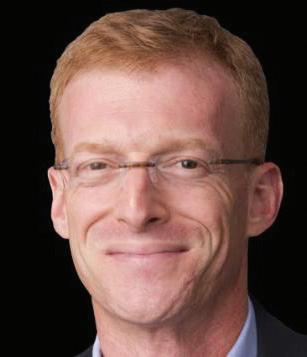
21 SUMMER 2023 MARQUETTE LAWYER
RESPONSE
THE STACK IN THE MACHINE
by Tejas N. Narechania
I am grateful for the opportunity to write a response— brief as it is—to a Robert F. Boden Lecture and, especially, to reply to one as rich and textured as James Speta’s contribution. This lecture, on treating internet platforms as common carriers, invites a wide range of questions: What analogy (if any) fits internet platforms best? Does the Supreme Court’s maxim—that the answer to problematic speech is more speech—ring as true in the 2020s as in the 1920s? What roles should competition and regulation play in speech-intensive markets?
Here, I focus on questions arising out of the lecture’s invocation of the debates regarding the Telecommunications Act of 1996. In many ways, the lecture revisits these prior policy exchanges, which asked how to best induce competition in markets that had been dominated by monopolists and oligopolists for nearly a century. Some favored greater investment in the basic (and expensive) network facilities—the wires and antennae, say—that formed the base of the telecommunications industry’s technical “stack,” and so advocated for more direct subsidies in such infrastructure. Others looked higher in the stack, striving to design a competitive market of retail service providers by designating network facilities owners as wholesalers. And still others thought that competition was an imperfect substitute for regulation, advocating instead for rules directly prescribing the good conduct that many hoped competition would induce.
Speta’s lecture considers the modern debates over today’s dominant and consequential internet platforms from a similar perspective. It eschews calls for direct regulation (as with Texas’s statutory scheme) and instead focuses on designing a competitive platform market by regulating suppliers—e.g., the hosting and cybersecurity service providers—to that market. Put in terms of those prior debates, it advocates for regulating the wholesale operations of certain infrastructural providers, thereby ensuring a more competitive market for the platforms that sit atop (i.e., are higher in the stack than) such providers.
I do not disagree that competition among platforms might help address problematic platform speech by creating a race to the top: Platforms might compete for user attention by developing policies to promote and induce speech that users want, while discouraging speech they don’t. And while reasonable readers might disagree over whether competition will come quickly enough (a critical error in the plan of the 1996 Act), or
even whether speech-related concerns are best addressed by a market-centric solution, it seems worthwhile to at least try to improve platform competition.
Let me offer a complementary proposal, then, to the lecture’s call for regulating, as common carriers, providers of hosting and cybersecurity services. Such infrastructural providers may indeed require more substantial regulation. But we might also look to the stack within platforms for an even more targeted approach to inducing competition. A single platform serves (at least) two functions: one, a transport function (the transportation of, e.g., tweets or toots); and two, a display function (namely, the curated and edited display of those tweets and toots). We might treat each platform as both a wholesale and a retail provider of social media services: we might require that the transport services of various platforms interconnect with each other, while letting each platform make its own decisions about how to display and moderate the social media content that flows across the entire ecosystem.
In this respect, I do not share the lecture’s concern that an interconnection requirement would intrude on any editorial voice. By separating the transport function from the display function, each platform retains the discretion to display content to its users however it sees fit. Meanwhile, interconnection in transport—one cornerstone of the 1996 Act—makes each platform even more content-rich, amplifying network effects across providers and making it easier for users to switch from one platform to another.
Particulars aside, James Speta’s thoughtful Boden Lecture reminds us to look ahead to the possibilities of the future while drawing on the lessons of the past. Here, there is plenty of both: the laws, technologies, and markets that compose the platform ecosystem will churn substantially in coming years, and there is more than a century of precedent to help guide—without dictating— our approach to the challenges and opportunities ahead.
Tejas N. Narechania is the Robert and Nanci Corson Assistant Professor of Law at the University of California, Berkeley, and a faculty director of the Berkeley Center for Law & Technology.
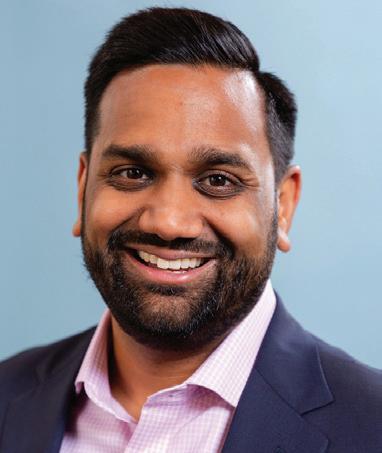
22 MARQUETTE LAWYER SUMMER 2023
become largely unusable for the reason that I have already said: given the galaxies of information on the internet, on social media, and even in most individuals’ networks, the platforms must select.
The Fifth Circuit simply did not understand what platforms do. It said that Miami Herald v. Tornillo, the Supreme Court’s 1974 decision, was distinguishable because “when the State appropriated space in the newspaper or newsletter for a third party’s use, it necessarily curtailed the owner’s ability to speak in its own forum.” But, contrary to the Fifth Circuit, government-imposed common-carrier laws, including the Texas law, necessarily curtail the speech experience that the platforms are attempting to create.
This leads to my most significant concern: the statutory solutions being proposed do not have any viewpoint-neutral or content-neutral hook on which to base a nondiscrimination requirement. Telephone calls, although they carry speech, are simply electronic transmissions executed by sending and receiving equipment. The traditional common-carrier nondiscrimination rule thus asks only whether each customer has access to the same equipment and is able to make the same electronic transmissions. Nothing—nothing—in the regulatory structure requires or permits the government to look inside the transmission to see what is being said.
By contrast, the proposals that go under the banner of “common-carrier rules for platforms”

decidedly do give government this power. By statutory text, they require viewpoint neutrality, and they require the platforms to give the government access to algorithms and data so that the government can determine whether there has in fact been viewpoint discrimination.
A common-carrier case can be decided without consideration of the content or the viewpoint of the excluded speech; not so under these new statutes. They strike at the core of the First Amendment, which forbids government the power to select content (or to dictate to others the selection of their content).
If anything, government power over the choice of viewpoint has been thought even more problematic. And these statutes are in fact targeted at viewpoint—their sponsors have told us so. Should we not be especially suspicious of legislation that has been explicitly offered as a way to promote certain viewpoints?
It is not necessary for me to endorse any of the more difficult intermediate moves that have been debated in free speech law and the digital age. Nor do I believe that this concern requires a view that algorithms or the outputs of algorithms are, themselves, speech, as Professor Stuart Benjamin has argued. The statutes empower the government to require changes to the platforms’ algorithms, and that threatens direct government control over the speech ecosystem.
A BETTER INTERNET
This leads to my most significant concern: the statutory solutions being proposed do not have any viewpoint-neutral or content-neutral hook on which to base a nondiscrimination requirement.
I also do not need to say that the platforms engage in “editorial discretion,” as that term has been used (and much debated) in media and communications cases. (Yet I will of course agree that what I have said about platforms’ need to discriminate bears a very strong resemblance to editorial discretion.)
A BETTER APPROACH: FOCUSING ON INFRASTRUCTURE
So, what might we do if you, like me and many others, share the dual concerns that, on the one hand, platforms have unusually significant (even troubling) sway over our speech and commerce and that, on the other, empowering government to control viewpoint dissemination on platforms is problematic?
You don’t have to agree with Texas and Florida that platforms are discriminating against conservatives. You need not embrace the views of progressives that the platforms allow far too much fake science, conspiracy theory, racism, and the like. You might, as was the case in the late 1800s, simply be uncomfortable with the degree of power that these few platforms have over speech and commerce. So what might you do?
More Platforms
My answer comes from the Supreme Court’s consistent invocation that the solution to problematic speech is more speech. The solution to problematic platforms is more platforms. There’s nothing particularly new about that, as internet entrepreneurs have regularly tried to create new platforms and services by distinguishing themselves from existing players. Few succeed, at least for any significant period. But some do. It has taken little more than a year for TikTok to go from a startup to one of the most visited sites on the internet.
Indeed, as you may know, several platforms have started or offered new practices specifically to respond to perceived viewpoint inadequacies on the current platforms. For example, a product called “Gab” launched in 2016, was promoted explicitly as a “free speech” alternative to Twitter, and was principally targeted toward conservatives. Parler was launched in 2018 and similarly marketed itself as a “free speech” alternative to Twitter and Facebook. Some reporting has suggested that neither new platform was as open and unmoderated
as advertised, but we must agree that they are alternative platforms, free to set their own access and moderation policies. And of course Truth Social is now the principal platform for former President Donald Trump—in fact, it is owned by Trump—and it formed after he was removed from Twitter and Facebook.
Starting a new platform is not easy. Economically, it requires scale, and the “network effects” that the largest platforms currently enjoy are difficult to replicate. But it is not impossible, for network effects can also make markets tippy. That is, users will move very quickly to a new service that is perceived to be better, so long as that is the shared perception. For those of you not of the TikTok generation, recall how quickly Yahoo search replaced Altavista, Google search replaced Yahoo, or VHS conquered Betamax once everyone started to care about videotape.
Even more importantly, unlike the case with telephone service, consumers and users can very easily be on more than one platform. Have you ever checked if Lyft could give you a better price than Uber? Or if Expedia can find you a cheaper flight than Orbitz? It’s just a few quick taps, because your smartphone can have both apps. Indeed, the key to real-time competition between Uber and Lyft— apart from their drivers, cars, and riders—is that each company’s app has access to the smartphone, directly or through an open browser.
What do new platforms need to compete with the old, other than subscribers? They need the infrastructure on which platforms depend. These are all of the services we discussed earlier. Usually, these pieces come together relatively seamlessly, for in fact selling hosting or transport or cyberdefense services is in the economic interest of companies. Each usually wants to work with new startups, for new companies increase revenues, especially if they take off as only a new internet company can.
Even so, on several important occasions, we have seen new or alternative platforms being denied these supporting services and consequently losing their ability to reach users. Both Gab and Parler had this happen, when their hosts and payment services terminated their relationships, stating that they did not wish to be associated with the sites. Both Apple and Google removed Parler from their app stores. Cloudflare, the largest cyber-defense company, terminated 8chan, which had long been an alternative platform. And just this month, Cloudflare
continued on page 27
24 MARQUETTE LAWYER SUMMER 2023 A BETTER INTERNET
My answer comes from the Supreme Court’s consistent invocation that the solution to problematic speech is more speech. The solution to problematic platforms is more platforms.
COMMON CARRIAGE AND CAPITALISM’S INVISIBLE HAND
by Eric Goldman
I’m honored to comment on Professor James Speta’s Boden Lecture, “Can Common-Carrier Principles Make for a Better Internet?” Like many other academic works about the telecommunications industry, the lecture analyzes the telecom “stack,” which models how various “layers”—from the physical infrastructural layer to the layer of content transmitted over the network—combine to enable electronic communications.
The lecture focuses on the Florida and Texas laws passed in 2021 that constrain content-moderation decisions by online publishers of third-party content. Professor Speta argues—correctly, in my opinion—that these publishers, located at the top of the telecom stack, should not be subject to common-carriage principles, even when they are “dominant platforms.” Professor Speta notes that “platforms” necessarily prioritize some content over other content and classifying them as “common carriers” would negate this core function. That makes the Florida and Texas laws censorial, blatantly unconstitutional, and terrible policy.
The lecture then takes up circumstances where expanded common-carriage principles nevertheless might help to address platform dominance. Professor Speta argues for the imposition of access and nondiscriminatory obligations (common-carriage-lite, we may call it) among some vendors occupying layers between the online content publishers and the physical telecom layer. He describes the entities of interest as “infrastructure that enables platforms to be built and to reach consumers.” His hope is that regulating these vendors will enhance the overall competition in the telecom stack layers above them, which could increase the number of platforms and spur more vigorous competition among them. I had two main problems with this argument.
First, Professor Speta doesn’t precisely define exactly which entities should be targeted for these obligations. Professor Speta refers to several categories of telecom stack vendors (he calls them “the internet’s support providers”) that might be sufficiently infrastructural, including app stores, web hosts, anti-DDOS services, and payment systems. However, these vendors are quite disparate in nature, so I can’t tell why these niches all warrant equal regulatory treatment.
Indeed, each niche has its own unique attributes that cut against these burdens. For example, like bookstores, app stores curate third-party informational resources that consumers can buy. Professor Speta says bookstores shouldn’t and couldn’t be treated as common carriers, but app stores may qualify for common-carrier-lite status. Why this dichotomy?
Second, the same infrastructural dynamics might apply to many other industries, not just some players in the middle of the telecom stack. Businesses routinely become critical vendors to other businesses or their customers. When should these businesses across our economy also be subject to common-carrier-lite principles?
Here’s my answer: rarely. For good reasons, we don’t require businesses to accept customers and treat them equally except when absolutely necessary. Capitalism’s “invisible hand” assumes that parties freely enter into contracts. This self-interested autonomy enables the efficient allocation of goods and services to those who value them the most. Common-carrier obligations (even a lite version) override this economic freedom, thus conflicting with one of capitalism’s basic tenets. Common-carrier obligations also override associational liberty—a point the Supreme Court is likely to address in the pending 303 Creative LLC v. Elenis case.
While common carriage is a venerable part of telephony regulation, it’s an extraordinary regulatory intervention for most sectors of our economy. Accordingly, advocacy for expanded common-carrier-like obligations should prove that exceptional treatment is needed and reconcile the many associated policy tradeoffs. That task was beyond the scope of Professor Speta’s lecture, but it will be a necessary step before I can embrace the argument.
Eric Goldman is associate dean for research, professor of law, and co-director of the High Tech Law Institute at Santa Clara University. He was assistant professor of law at Marquette University from 2002 to 2006. Email: egoldman@gmail.com. Website: http://www. ericgoldman.org.
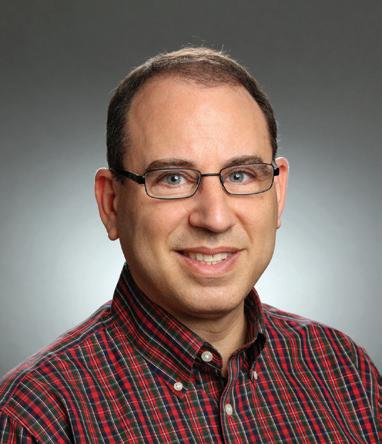
25 SUMMER 2023 MARQUETTE LAWYER
RESPONSE
CONFRONTING THE WAVICLES OF MASS MEDIA
by Bruce E. Boyden
When the internet burst into public consciousness in the mid-1990s, there were euphoric hopes that the age of participatory democracy was upon us, that the voices of individuals would be finally freed from the gatekeeping of mass media conglomerates. But it turns out that most people simply do not want to read every single random thought posted to the internet; they want access to as much content as possible, but they want it filtered and organized. And only large enterprises—Big Tech—can offer both of those things at once. Meet the new boss, same as the old boss.
So it is unsurprising that many people have concluded that we have, in fact, been fooled again. Legislators have picked up on this disenchantment and have begun passing laws aimed at curbing the powers of social media platforms to decide what content can stay up and what should be removed. Jim Speta, in his wonderful Boden Lecture, has addressed one such legislative solution: common-carrier regulation of platforms. For the reasons Professor Speta states, common-carrier obligations are a poor fit for the content on platforms, but such duties have considerably more promise in regulating the markets that serve platforms, as a way to reduce the dominance of the existing oligopoly.
Professor Speta’s affirmative proposal has a lot to recommend it, but I think the benefits would unfortunately be attenuated. The widespread anger at how platforms manage the content on their services isn’t simply due to a lack of alternatives. It has more to do with a clash of long-standing social and legal norms that has bedeviled internet law and policy since the beginning.
Old media were divided into two types: transmission and content. Services tended to fall into one or the other, and societal expectations formed around which category a service happened to be in. Transmission services sold individuals the ability to get their message from Point A to Point B, and as a matter of practice they engaged in little to no monitoring or control of the content of those messages. Content services, by contrast—radio and television networks, newspapers, book publishers, and the like—assembled a large crew of paid contributors to produce entertainment, art, or news, which they then distributed to viewers in a one-way communication. Viewers could pick and choose what service they would watch or read, but otherwise had no input in its substance.
Legal rules accreted around these expectations. Over time, transmission services became subject to extensive regulation governing their operations, including common-carrier rules, but were largely free from liability for the content of messages sent through their facilities. Content services,
meanwhile, were largely free from government regulation of their operations, but were subject to liability for what they chose to publish.
The internet screwed all of that up. The problem is that modern media—the social networks, search engines, video-sharing sites, and online shopping markets—combine elements of both transmission and content. They are the wavicles of mass media. Like transmission services, they offer individual users the ability to communicate with each other, largely unfettered. Like content services, they assemble and organize a stream of information to provide to their users, and they are constantly selecting whose messages to promote and which users to drop. But unlike any of the old media, the producers of modern media are also the users—the path is circular. Not only is the public perception of platforms jumbled, so is their legal regulation. Platforms edit and organize the content that flows in from users, and so they claim freedom from government regulation under the First Amendment. But thanks to the Communications Decency Act, 47 U.S.C. § 230, platforms are also shielded from liability arising from that content. Although there is nothing inherently contradictory about this result, the tension with old media norms helps to explain the otherwise puzzling reaction of the Fifth Circuit to Texas’s social media law in NetChoice, LLC v. Paxton, the 2022 decision noted by Professor Speta. The NetChoice majority evidently viewed Twitter, Facebook, and the rest as basically just fancy party-line phone calls. Viewed from that perspective, selectively deleting messages and booting users constituted “censorship” of communications and not editing of contributions.
It’s easy to deride the uncritical sloganeering of the Fifth Circuit, but harder to state what norms should govern an enterprise that assembles content gathered from users, repackages it, and provides it back to those users as a service. Professor Speta’s proposal to encourage more competition for this odd wavicle of communications technology is worth adopting, but the weirdness of such content—which, like Schrödinger’s cat, is both user speech and platform speech at the same time—will continue no matter how many platforms there are.
Bruce E. Boyden is associate professor of law at Marquette University.
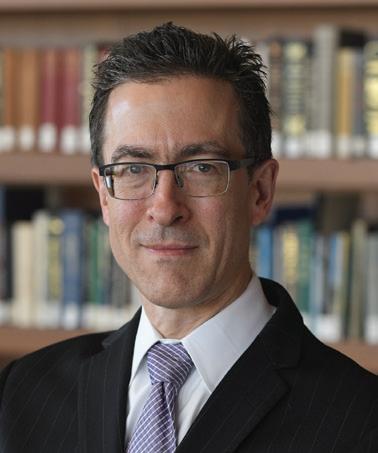
26 MARQUETTE LAWYER SUMMER 2023
RESPONSE
effectively blocked Kiwi Farms—and it did so even after Cloudflare’s CEO had publicly announced that it would not, saying that he did not want to be making such decisions based on the “ideology” of the company’s customers.
Now, to be sure, in some cases, the terminations arose based on violent and hateful statements posted on these networks. But the fact remains that, in each case, the providers of infrastructure made a decision that effectively removed or significantly diminished a new platform’s access.
A Common-Carrier Approach to Infrastructure Would Help New Platforms
It is to these supporting services that a common-carrier rule could be targeted, to ensure that alternative platforms have the kind of access needed to create more effective competition with the existing platforms—and with whatever might be wrong with their practices. That rule need do nothing more than say that the ISPs, the hosts, the app stores, and the cyberdefense companies must grant access and services to new platforms and services on the same terms on which they grant access and services to other platforms and services.
I would add to this that denial of service would be presumptively disallowed whenever that denial would cause the platform to lose access to a substantial number of prospective users. We aren’t talking about any of the most heavy-handed parts of common-carrier regulation—rate regulation or filing of rate schedules (tariffs) or universal service policies. My proposal is common-carrier inspired, not common carriage.
I think that many or even most of the infrastructure services might welcome such regulation. As many of these episodes have revealed, some of these companies have become the targets for significant pressure campaigns. Legal access requirements would provide a quick and easy answer for what is overwhelmingly the business decision they already make (and want to make) as to 99 percent of all customers.
Finally, although I am generally disinclined toward platform regulation, I do think there is one move that might be made there, one that would support the idea that the solution is more platform competition. Specifically, government could take steps to ensure that customers can more easily switch to new platforms.
Common-carrier regulation and related utility
regulation often used interconnection requirements to facilitate entry. Interconnection overcomes network effects, because a customer can switch its own provider but still have access to everyone remaining on the original network. A full-blown interconnection requirement on platforms, however, would suffer the same problems as an access requirement, because it would effectively result in the same intrusion to each platform’s curation.
But, well short of an interconnection requirement, government could still make switching easier, by ensuring that users are able easily to download their own data from incumbent platforms—for example, to take all of their pictures to a new service. Indeed, in the original Federal Trade Commission (FTC) antitrust investigation of Google in 2010, in which the FTC decided against an enforcement action, one meaningful concession that it did secure from Google was easier exit for advertisers, by allowing advertisers to more easily capture their campaign data from Google.
Let me return to the main motion, if you will. For three reasons, I think my proposal to focus access and nondiscrimination requirements— common carriage of this light-touch sort—on the infrastructure or support companies could work and does not suffer the principal difficulties of directly regulating the platforms’ own access and content decisions. This should increase the ability of new platforms—coming from whatever perspective—to start service.
First, there is here, unlike with the platforms, a non-content-based, non-viewpoint-based hook. That is because we are, as in the case of our old friend, the telephone (and its regulation), simply talking about electronic access. Sure, transport companies, web hosts, payment systems, and cyberdefenders could today choose with whom they do business based on the content in which their customers deal. But they overwhelmingly do not.
This fact—that they overwhelmingly do not select or refuse business based on their customers’ content—is one of the fundamental reasons for the success and diversity of the internet that we have today. In fact, I envision that, for most infrastructure segments, disputes will be rare, as hosting and payment systems, for example, have numerous providers.
Second, the access rule need not be a universal service requirement, interfering with fundamental planning decisions such as capacity. An infrastructure provider could deny service
It is to these supporting services that a common carrier rule could be targeted, to ensure that alternative platforms have the kind of access needed to create more effective competition with the existing platforms . . . .
27 SUMMER 2023 MARQUETTE LAWYER
A BETTER INTERNET
I do think that we should consider whether, in our environment of only two mobile operating systems (and therefore only two app stores), government should require access for alternative app stores.
if it simply didn’t have the room. But this, too, should be rare. Historical common carriage did not inherently deny railroads or telephone companies the ability to manage capacity on their networks— so long as they did so evenhandedly. And commoncarrier companies could deny access to illegal or threatening uses.
In any event, the contrast is that an access and nondiscrimination rule for a platform would significantly interfere with its core business decision—how to shape the content experience for its users.
Third, for similar reasons, a common-carrier rule only for infrastructure services would not give the government tools to directly change the content and viewpoints being offered. Government would look only to the fact of access to electronics and services, not inside the content and viewpoints being offered.
The bottom line is that this is a matter of comparative regulatory analysis. If we are concerned about the dominance of platforms and reaching for common-carrier analogies, we can (apart from doing nothing) try to regulate the platforms directly, as Texas is doing. Or we can regulate the infrastructure and thereby indirectly promote competition with the existing platforms.
I think the option of regulating the infrastructure is comparatively better, for it doesn’t use government power to change the speech experiences directly. In First Amendment law, the Court often asks whether a regulation is the “least restrictive means” of pursuing the government’s goal.
As I said at the outset, I don’t need to convince you that common-carrier regulation of platforms violates the First Amendment. I hope that I have convinced you that the alternative of focusing on the infrastructure is a better solution, because it gives the government less direct power over our most important speech experiences.
SOME OBJECTIONS
Now that I have set out the proposal, let me address a few objections, identify my most significant uncertainty, and conclude with an attempt to reconcile what I am saying today with my own initial objection to nondiscrimination rules for ISPs.
The first objection to this proposal would be factual: to my claim that most infrastructure companies are, in fact, not “curating” their customer list. The most pointed objection might come from
Apple, which has been quite clear that it has a theory of those apps that should be permitted on its App Store. In the Epic Games v. Apple antitrust litigation, in which Epic sued over Apple’s removing the game Fortnite from the App Store, Apple has emphasized that it selects apps carefully. It requires apps to protect user privacy and data, not to contain malware, and to protect children, among other things. Many users and app developers want these policies. (In the interest of full disclosure, in another capacity, I helped write an amicus brief for app developers that endorsed Apple’s policies.)
The answer, I think, is twofold. On the one hand, common carriage did not actually forbid a company from setting terms and conditions on its users and their use of the network. On the other hand, I do think that we should consider whether, in our environment of only two mobile operating systems (and therefore only two app stores), government should require access for alternative app stores. The handset and operating system manufacturers could issue warnings, and government could require app store policy disclosures. And mobile operating system providers—Apple and Google—could still set prices for alternative app stores. Korea has imposed such a rule, and this gives us an opportunity to see how it unfolds. More pointedly, Apple or other service providers might say that the few instances of deplatforming (as with Gab and Kiwi Farms) came only when the speech on those platforms was violent and threatening. Here, again, an access requirement that retained a company’s ability to remove illegal threats would not offend commoncarrier principles.
The second objection would be legal, and it would return us to the First Amendment. When the FCC briefly adopted net neutrality requirements, imposing nondiscrimination requirements on broadband ISPs, the D.C. Circuit affirmed those rules against a First Amendment challenge. But there was a dissent by now-Justice Brett Kavanaugh (not a past Boden lecturer, but a past Hallows lecturer here). He wrote that ISPs exercised editorial discretion and that, in the absence of market power, the net neutrality rules offended the First Amendment. I think that he was wrong, both as a factual and as a legal matter. Much ink has been spilled on this particular debate.
Let me echo two main points. ISPs have not made transport decisions on the basis of content. And, more importantly, the First Amendment should be satisfied by a rule that does not prohibit
28 MARQUETTE LAWYER SUMMER 2023 A BETTER INTERNET
any speech and actually increases speech in the ecosystem. This is not inconsistent with my argument earlier, for a nondiscrimination rule applied to platforms necessarily suppresses the platforms’ preferred speech experience.
In all events, the access rule that I have in mind would require, as a threshold matter for its enforcement, some showing (whether by the private party or the government agency) that the denial of access left the alternative platforms with significantly diminished access to users. That ought to be enough even for those who agree with Justice Kavanaugh.
While I don’t think much of either of these first two objections, I do think there is a more significant objection still to be made—and that is to the splintering of the dominant platforms at all.
Traditional mass media was highly intermediated—with newspapers and networks choosing almost all of the information that received significant distribution. That intermediation had two effects: First, it created some strong incentives to appeal to the largest audience, which meant leaving off the niche and the fringe. Second, at least as to several important elements of the mass media, journalistic ethics and elite ownership exerted significant content control, again tending to cut off the niche and the fringe.
The internet has eliminated the power of this traditional intermediation, but platforms have been partially recreating it. The dominant platforms have now, to some extent, developed significant content moderation capabilities, and some of this explicitly removes false information, conspiracy theories, and the like.
Perhaps re-fragmenting the platforms will result in more distribution of the niche and the fringe— convincing people to adopt or embrace it, to the detriment of civil society, democracy, and social cohesion.
I will concede that this gives me pause, for we know that those exposed to fake news and conspiracy theories often adopt those views. For now, though, I think the following: that the internet is a fact; that the “more speech” genie, including the niche and the fringe, cannot be put back into the bottle; and that this is generally a great part of the internet age. In general, we must trust people with information (and enhance through education and other means their ability to discern good information from bad) and expect that competition or at least the threat of competition will make the platforms better.
Finally, let me note a potential inconsistency with my own prior writings. As I said at the outset, I have been working on questions of common carriage and internet policy for more than two decades. I have written that nondiscrimination rules for broadband ISPs were not necessary; indeed, I first made my name in this field (if any I have) by offering that view just as Professors Larry Lessig and Mark Lemley were writing the opposite.
I still think, fundamentally, that this view was correct: that ISPs will generally have the economic incentive to provide all services, that there are very good reasons to permit ISPs to offer differential service packages, and that markets are heading in the direction of competition. I did not, however, account for the possibility that ISPs (and, as relevant here, other infrastructure companies) might be targeted with ideological pressure campaigns, from the right and the left, that could significantly alter their economic calculations.
Nevertheless, the rule that I propose here is not significantly different from my earlier intervention. Net neutrality’s premise is that nondiscrimination itself is the legal test, and any discrimination is therefore legally suspect. In what I propose, the type of access denial and discrimination covered is more limited and, when coupled with a required showing that the denial is paired with substantial loss of access to potential users, the rule requires more than a showing of discrimination.
CONCLUSION
Communications networks are built to enable communications. While the internet and the myriad services offered have made the infrastructure much more complicated, we can still profitably distinguish between the ultimate creators of content and content ecosystems and the companies that enable those creators. The platforms are in the first group, and common-carrier-inspired access and nondiscrimination rules would significantly interfere with their operation and hand the government too much control over speech.
By contrast, in the case of the second group of companies, a light-touch access and nondiscrimination requirement forbidding contentbased denials of service, when such denials substantially reduce a platform’s access to potential users, would provide the superior option of competition and more speech.
I am grateful for this opportunity to engage with you on this.
29 SUMMER 2023 MARQUETTE LAWYER
In general, we must trust people with information (and enhance through education and other means their ability to discern good information from bad) and expect that competition or at least the threat of competition will make the platforms better.
Seeking Dignity and Connectedness in the Digital World
Congressman Ro Khanna offers a vision of people being meaningfully heard online.
The Marquette Lawyer arranged a conversation between Professor Jim Speta and Congressman Ro Khanna of California. This is an edited transcript of their exchange, which, like the foregoing Boden Lecture and responses, takes up important topics in internet policy making.
QCongressman Khanna, thank you for the opportunity to talk about internet policy, and thank you for generously engaging with the Boden Lecture. I want to start with your recent book, Dignity and the Digital Age: Making Tech Work for All of Us (2022). The book has a really comprehensive agenda for digital equity. For those less familiar with it, can you say a little bit about what you mean by dignity and how it is particularly under threat in the digital age?
AThere are two aspects to what I meant by dignity. The first is dignity in the sense of having agency—that we respect people by empowering them to fulfill their potential. One disempowering aspect of the digital age is the lack of productive work and economic opportunities for many people in many places. So the first half of the book talks about how we create opportunities for
individuals to be productive, to generate wealth, and to contribute in an age where software and digital technologies are having a greater and greater impact on the economy.
Then the second half of the book explores what dignity means in terms of citizenship. There seems to be a sense that only a very select few are getting to design the architecture of the digital public spaces. There often is a disconnect between the ability to participate in the digital public square and how that affects policy. It used to be that people would go to their town hall or go to their school board meeting and they would not just be speaking and participating but were actually influencing policy under elected officials.
My sense of a lot of what’s going on online is that, while people may be tweeting and retweeting and expressing their views, it’s not connected enough to government actions. It’s not the traditional public square in the way we think of it— which is not just a conversation but actually having an impact on government action. And then let’s think about what the many online spaces are where people can have an impact on government policy. How can people affirm their citizenship? And what do the variety of discursive spaces look like?
That was something I felt was very attractive about your Boden Lecture, and we’re both saying that one of the answers is to have more discursive spaces online for different types of purposes in terms of empowering citizens.
QYou are worried then that the internet platforms—Google, Facebook, Twitter, and
30 MARQUETTE LAWYER SUMMER 2023
others—have become places where there is discussion but the discussion isn’t serving the greater political purposes or engagement?
AYes, at least sometimes. At some moments, being online has positive effects. It was an appropriate place for expression of legitimate anger and organization and mobilization. You look at the Arab Spring, many years ago, and that was probably a time social media was working. But I think, a lot of times, one of the reasons people are so angry on social media is they almost feel that their expressions don’t matter. So it leads almost to a frustration. Contrast that, for example, with Taiwan, not that Taiwan is ideal, but where they have a digital forum, where people are ranking policy choices and the government is actually listening to it and it’s more constructive.
One of the challenges for us in a digital age is how we build institutions online that are not just more deliberative but that are more impactful of policy. I think that that is missing today.
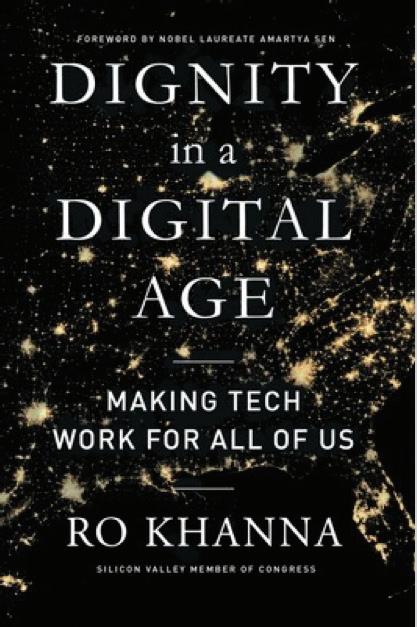
QYou are engaged significantly with online spaces, and certainly we had a recent president who was quite engaged with online digital spaces. Do you think it’s the case that individuals in government are just not involved enough with these digital spaces currently?
ANo, I think the issue is more formal than that. I am online, and I’ll often go to Twitter or Facebook to get a sense of what at least some activists are thinking. But I don’t think that the conversations are as granular or full as the conversation I may have had this weekend at a town hall in my district.
I get much more of a sense of what’s going on in my community and what people are thinking in a town hall like that than I may right now on social media. Now that may be partly who’s participating in social media—is it really a representative of a community? But it’s also the way these conversations are taking place.
“I think right now we only have a limited imagination of what social media should look like. . . . I’d love to see more intentional efforts at offering the types of communication online that can contribute to policy making.”
— Ro Khanna

31 SUMMER 2023 MARQUETTE LAWYER
Congressman Ro Khanna
One of the things I like about your lecture was the point that while there may be a place for Twitter or Facebook, the question is whether we can have other spaces as well that approximate town halls or have other modes of communication.
I think right now we only have a limited imagination of what social media should look like. It’s probably because it’s early. I’d love to see more intentional efforts at offering the types of communication online that can contribute to policy making. I don’t want everything to be boring. There’s a time for anger and protest. And that’s why some of the social media is fine, but I don’t think it’s fully developed in all the types of discursive spaces that we see in the non-online world influencing government policy.
QOne of the big criticisms of the platforms forming the new public square—in fact, it’s the criticism that prompted the lecture—is the idea that the biggest platforms are systematically discriminating against conservative voices on the platforms. That concern is what prompted the Texas legislation and the Florida legislation and also bills that have been pending in Congress. What do you think of the criticism that the platforms’ contentmoderation policies are politically biased and otherwise unfair?
AFactually, I think it’s hard to argue that conservative voices are being unfairly squelched. If you look at Facebook, for example, or if you look at the 10 most popular political sites, I think eight or nine of them are conservative or Republican-leaning sites. I think it’s an appropriate criticism that certain forums may be censoring based on viewpoints and that they should be more careful to have wide-open, robust debates. That’s not because they’re obligated to follow the First Amendment. They’re obviously not government actors. It just may be better for them to look at the First Amendment principles as a practical matter.
I think, though, that content moderation has affected the people on the left as well. I guess I want to see data that suggest that it’s been more prevalent on the right as opposed to anyone else. And if the data were there, I’d be open to it, but it seems to me that a lot of times people make that criticism without providing the evidence of it.
QIn your book, you write about contentmoderation policies, and you seem drawn to
the idea of oversight boards, such as the Facebook Oversight Board, to engage community and experts together to help make these decisions. Would you like to see those sorts of engagements made more broadly throughout the platform space?
AI would, and I especially want more transparency on why the decisions are being made. I propose a right of appeal if someone gets censored or, certainly, if someone gets deplatformed. There should be clear guidelines. I think a lot of the problem right now is a lack of transparency and a lack of a process that these platforms have.
I also agree with you that having many of these sites, as much as possible, is a good thing. Now I think one of the challenges is that the more discursive sites you have, the more spaces you have, platforms you have, you create the risk of the fragmentation of public discourse—where all the conservatives go to one platform, say Truth Social, and all the liberals go to a different platform. I think that’s problematic because then we’re not talking to each other at all. I think there’s a tension between having a plurality of platforms, which decreases the risk of voices being suppressed, and having forums for exchange with people who don’t share our views. And I think that that is something we have to try to figure out. How do we do both?
QDo you think there’s a role for government either in being the appellate body on contentmoderation decisions or perhaps in building new spaces that maintain a form of universal connectivity?
AI certainly think, on the latter, there’s a role for government to incentivize, encourage, support efforts that are encouraging conversation with the people who disagree with each other online.
I’ve been very drawn to work that James Fishkin at Stanford has done with deliberative polling and bringing people from different backgrounds into living-room conversations. Could you do those living-room conversations online with people in different geographies? I think government could try to encourage and facilitate it, the way government does in a town hall.
But I also think that the platforms have to see themselves as stewards of democracy, in the way that newspapers and broadcast television did. If newspapers were simply profit-maximizing, they would never publish my op-ed. Many people write
32 MARQUETTE LAWYER SUMMER 2023
A BETTER INTERNET
op-eds that would go more viral. And probably no one would ever put me on television if profit were all that broadcast networks cared about.
So there’s a developed sense of ethics or culture where these traditional media institutions in the private sphere also see themselves as having a responsibility to democracy. I think that that needs to emerge with social media.
By contrast, I’m wary of government directly getting involved in adjudicating whether my tweet violated standards or whether I should be suspended from Twitter or not. I think that’s getting too close to the government being an arbiter of truth, which it should not be.
QYou represent the area of Silicon Valley. These internet platforms have largely come from a background of engineering and entrepreneurship, not from journalism schools and communication studies. How does that sense of journalistic ethics or democratic engagement evolve? And how do we as individuals make a claim on it? You discuss democratic participation in your book. How do we as individuals get more broadly engaged so that the platforms have the kind of ethics we want them to have?
AOne of the reasons I advocate for the democratization of who gets to participate in building the architecture is that it’s important for more people to have a stake in how the architecture is designed. Right now, I think it’s a very small group in Silicon Valley—engineers—making those decisions. The more we can get people from rural communities and the Midwest, from Black and brown communities, from all different perspectives, at the table, when these things are being designed, the architecture itself will be concerned about hate speech or censorship of conservative voices. So, I think one aspect of it is, how do you get more people involved in the architecture?
The second thing is that that these platforms started out by just hiring engineers and finance folks, which is understandable, and then they got lawyers for compliance. But they need to think about more people in the liberal arts, more people who are thinking about democratic issues, to be working there.
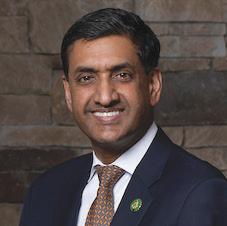
Now, what is their incentive to hire in those ways? I think as there’s more public scrutiny on their role in democracy, they may see that it is in their interests to have that concern. But, you know, it’s a big and difficult question to ask how culture emerges.
QHow did you personally come to focus on this work?
AFor one, I represent the district of Silicon Valley. Something that I was very struck by is that my district has $10 trillion in market value. The world is their oyster for a lot of people graduating out of Cupertino High or Homestead in Cupertino, or where Steve Jobs went to high school in Sunnyvale. But then opportunities aren’t there for so many other Americans, particularly with jobs going offshore and globalization. That’s really something that I have been interested in since going to Congress. You can’t advocate for spreading digital opportunity without addressing also the problems of the digital architecture and citizenship, and that’s why I started thinking about those issues.
QYour book includes a great story of a trip to rural Kentucky with other representatives, to meet people and to see digital training in operation. Alex Hughes was one of the people you met there.
AYou know, what was striking to me about Alex Hughes, a worker whose business closed when the local coal company shut down, was that he was about making things and building things. He continued to do so with the digital training that he received. Alex is not someone who is going to go become a software engineer or a coder for Google. But he wanted to build things, and now he is building ovens and refrigerators and doing it with the modern digital technology.
I’ve been a huge champion of bringing our production back to the United States. I call it a new economic patriotism. I really believe it was a colossal mistake for America to offshore so much of our production and manufacturing. One of the things that could allow us to bring production back is digital technology: Our robotics can make manufactured processes more efficient, and we can have machines communicating with each other through sensors or digital technology to be more productive.
Alex Hughes is, for me, a symbol of someone rooted in a community and yet making things, embracing the idea that making things with digital technology training doesn’t require a college degree. A theme also throughout the book is the importance of rootedness in community—of the ability to stay where you grew up and still have economic opportunity. That’s why I thought it so important to tell Alex’s story.
“I think there’s a tension between having a plurality of platforms, which decreases the risk of voices being suppressed, and having forums for exchange with people who don’t share our views.”
33 SUMMER 2023 MARQUETTE LAWYER
Congressman Ro Khanna of California
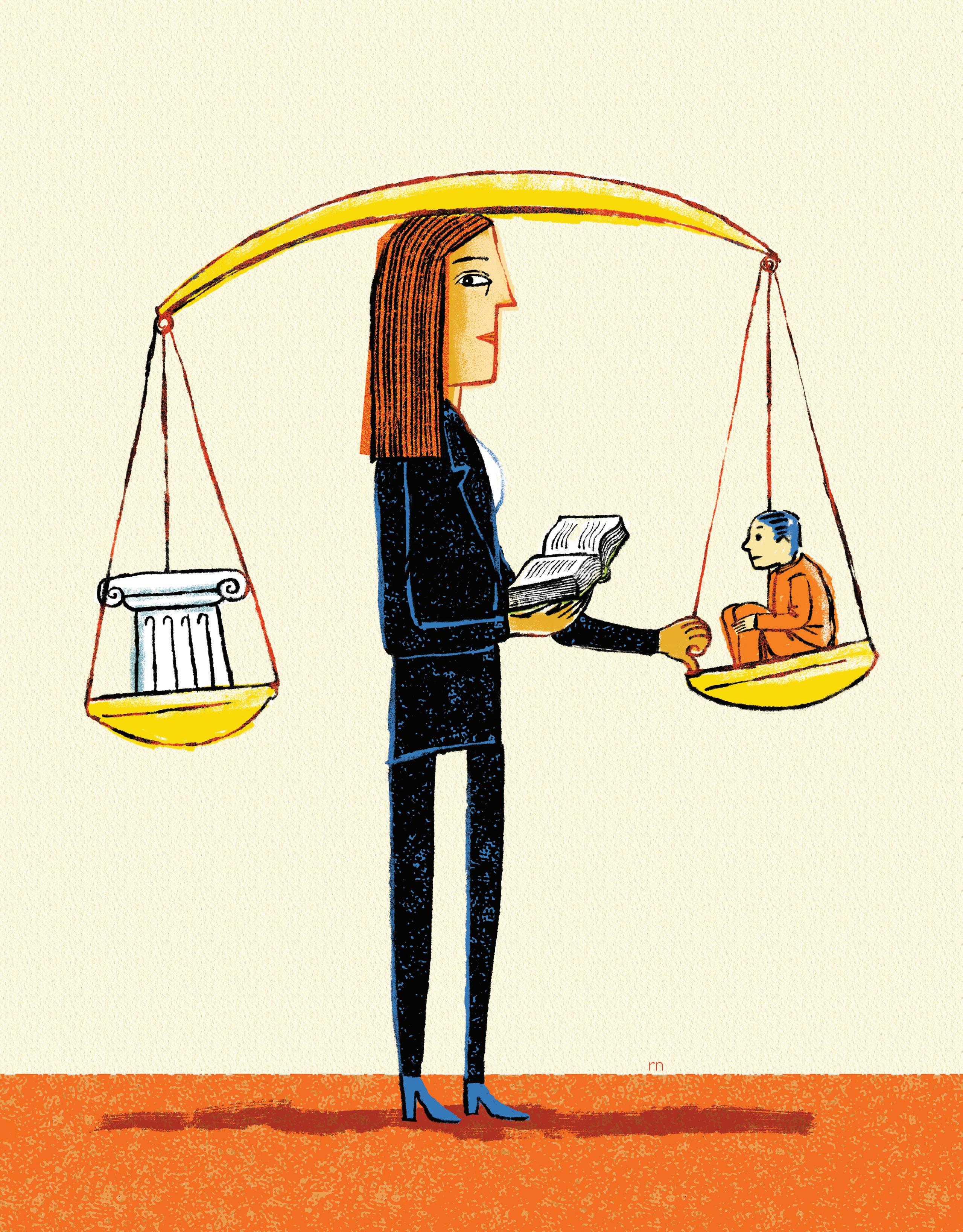
ACTING IN THE BEST INTERESTS OF CLIENT AND “KING”
In his 1776 revolutionary pamphlet, Common Sense, Thomas Paine wrote, “In America THE LAW IS KING.” In 1937, former Harvard Law School Dean Roscoe Pound maintained, “[T]here is no law without lawyers.”
Taken together, these statements help capture the outsized role that American lawyers have played in shaping American society. This has often left the general public uneasy, if not anxious. A new book by Michael S. Ariens, L’82—The Lawyer’s Conscience: A History of American Lawyer Ethics (University Press of Kansas 2022)—tells how, over time, American lawyers have attempted to justify the exercise of their power, often in the face of allegations that lawyers acted as their clients’ corrupted agents.
Ariens is a longtime student of American lawyers, serving as the Aloysius A. Leopold Professor at St. Mary’s University School of Law in San Antonio, Texas, where he has taught since 1987. His book’s provocative and extensive examination of American lawyer ethics merits attention.

Marquette Lawyer takes up The Lawyer’s Conscience, or engages with
the topic, in the following five entries. First is a description of Ariens’s book and its conclusions, drawing also on a conversation with the author. In the next three entries, reflections prompted by the book are offered by Marquette Law Professors Peter K. Rofes, Rebecca K. Blemberg, and Nathaniel Romano, S.J.; these are excerpts from their posts on the Marquette Law School Faculty Blog. The final section here is a portion of a 1982 Marquette Law Review essay by the late Robert F. Boden—dean of Marquette Law School during Ariens’s days as a student.
35 SUMMER 2023 MARQUETTE LAWYER
A Marquette lawyer’s new book, examining the duties and obligations of lawyers past and present, prompts a conversation, three reflections, and one look back.
Illustrations by Robert Neubecker
Professor Michael S. Ariens, L’82
Over 200 years, American lawyers attempted to assuage the public’s worries by noting that lawyers served both as loyal agents to their clients and as “officers of the court” or “servants of the law.”
A GLIMPSE INTO THE LAWYER’S CONSCIENCE: A HISTORY OF AMERICAN LAWYER ETHICS AND A CONVERSATION WITH THE AUTHOR, MICHAEL ARIENS
Michael Ariens wrote the book for both lawyers and nonlawyers interested in how the profession became so powerful. The Lawyer’s Conscience is divided into seven chronological chapters, beginning in 1760 and ending in 2015. Each chapter includes a number of short stories intended to exemplify one or more of the book’s themes. The work grew out of a question to which the author has found himself regularly returning in his teaching and writing: “How is it that lawyers are so powerful?” Ariens also mulled this follow-up: “How do lawyers justify possessing such power?”
Ariens cited Paine’s phrase that “the law is king” in response to the first question. And Ariens found the answer to the follow-up question in similar justifications made by lawyers from the late 18th century through the end of the 20th century. Over 200 years, American lawyers attempted to assuage the public’s worries by noting that lawyers served both as loyal agents to their clients and as “officers of the court” or “servants of the law.”
In addition, the ideal of a legal profession distinguished the lawyer from the ordinary agent of a business. The ordinary business agent was permitted to undertake any lawful action on behalf of his or her principal. Lawyers, by contrast, could not just do anything lawful on behalf of their clients; instead, they were constrained by their duties as “officers of the court” or as dedicated to the interests of the public. Although lawyers have often written to minimize the difficulty this dual role creates, Ariens argues that the duty to serve both the client and the public places lawyers in an impossible position. He sees no wholly satisfactory solution to this problem, but he suggests that some approaches are worse than others.
The Model Rules of Professional Conduct, promulgated by the American Bar Association (ABA) in 1983, were, in Ariens’s telling, a step in the wrong direction, and that project itself became a story about a deeply fractured legal profession.
Why Ariens reached this conclusion helped frame the book’s structure. Why did the ABA decide in 1977 to create a committee that crafted the Model Rules, especially when it had approved the widely adopted Code of Professional Responsibility just eight years earlier, in 1969? And why, by contrast, had it taken more than 60 years for the ABA to replace the 1908 Canons of Professional Ethics with that 1969 Code? What had driven the ABA even to draft the Canons in the early 20th century?
The move backward in time prompted Ariens to open the book with the (true) story of a young lawyer, writing in his diary in 1760 and fulminating about “pettifoggers.” A decade later, that lawyer—John Adams—successfully defended an officer, Captain Thomas Preston, and eight British soldiers accused of murder, in Boston Massacre trials. Adams privately noted the price he paid for his defending unpopular clients, which only decades later would be celebrated as a service tying the lawyer’s duty to both client and public. But Adams’s defense of the soldiers relied in part on attacking the character of those killed in the massacre, a point that often goes unmentioned during praise of Adams’s willingness to represent vilified defendants. The trials were an early American demonstration that lawyers sought to win—and that zealous advocacy helped them do so.
The examples of Adams in 1760 and 1770 generated several themes that course through The Lawyer’s Conscience . First, what standards should lawyers use to defend their work? In Adams’s time, for example, lawyers maintained that they acted honorably, whereas pettifoggers were dishonorable. Ariens argues that honor, an external standard, was displaced by conscience, an internal standard, beginning no later than the 1830s. Eventually, conscience was both supplemented and supplanted by ethics “rules.”
Second, the ideal of the defense of an unpopular client was honored by later lawyers, both in
36 MARQUETTE LAWYER SUMMER 2023 THE BEST INTERESTS OF CLIENT AND “KING”
the breach and in the observance. For example, during both the second “red scare” of the early 1950s and the civil rights movement of the early 1960s, the lawyer’s (and lawyers’) ostensible duty to represent unpopular clients, in order to help secure the rule of law, was widely debated. What, if any, repercussions existed if lawyers refused to represent an unpopular client, and what consequences was a lawyer expected to shoulder if representing such clients disrupted or even destroyed a lawyer’s ability to make a living? This debate segued into the question of cases and causes. In one framing of this issue, did the lawyer best represent a client by thinking of the matter as a case or as a cause?
Third, what limits, if any, did lawyers (or the law) place on zealous advocacy? This question has been answered differently at different times— before the Civil War and after it; between the two World Wars and after the Second; and during the 1970s and since the early 1980s. On this question, the ABA’s 1908 Canons, 1969 Code, and 1983 Model Rules offered different conclusions. Ariens, adapting Justice Oliver Wendell Holmes’s phrase about the common law, said that these disparate answers reflect the “felt necessities of the times” among lawyers.
The final chapter of The Lawyer’s Conscience is titled “The Professionalism Crisis and Legal Ethics
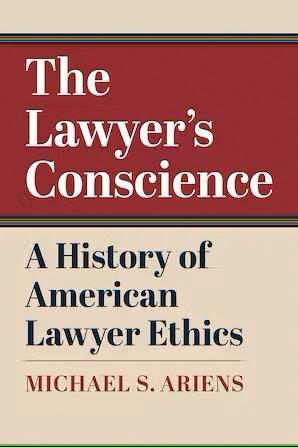
in a Time of Rapid Change, 1983–2015.” Ariens argues that the vociferous debates concerning the content of the Model Rules were a harbinger of a debate about identity. Were lawyers still members of a profession, as distinguished from a business, or were they better characterized as part of the legal “industry”?
The book’s conclusion notes not only Dean Roscoe Pound’s 1937 assertion that “there is no law without lawyers,” but also the conclusion, a half century later, by legal ethicist David Luban that “the lawyers are the law.” On such thinking, lawyers possess even more power than they may imagine.
It is the lot of lawyers, as one member of the profession suggested in an 1896 speech to ABA members, that they seek both to demand justice and yet to represent any paying client and “do [their] best to make that case prevail,” even when prevailing may appear unjust. So lawyers always act under a “strain of conscience.” That is the weight that lawyers have long carried in trying to serve both client and community. In what he calls a “love letter” to American lawyers, Ariens concludes that conscience is an imperfect guide on this journey, but that it is the only guide worth attending to.
Ariens argues that the vociferous debates concerning the content of the Model Rules were a harbinger of a debate about identity. Were lawyers still members of a profession . . . ?

37 SUMMER 2023 MARQUETTE LAWYER
MICHAEL ARIENS—LAW SCHOOL CLASS OF ’82—IS A DEEP AND DEFT THINKER
Peter K. Rofes

Ariens’s attention turns, finally, to the stretch of time from the end of World War II to today. A smorgasbord of developments within the profession gets discussed here. Two consume much of Ariens’s attention.
The first, led by Virginia lawyer Lewis Powell (yup: that Lewis Powell) beginning in 1964, concerns events leading up to and in the decade following the ABA’s adoption of the Code of Professional Responsibility in 1969. The second focuses on the surprisingly swift supersession of the Code with the ABA’s 1983 promulgation of the Model Rules of Professional Conduct.
Ariens admires the Code, in no small measure because, after each of its nine overarching canons, the Code enumerated a series of ethical considerations. The ethical considerations, as Ariens reminds us the Code’s preamble itself reported, were “aspirational in character and represent the objectives toward which every member of the profession should strive.” He praises the aspirational structure of the Code, contending that such a structure conveyed to practicing lawyers that their professional lives should be devoted at least in part to grappling with the moral challenges of law practice and examining their consciences for answers to such challenges—as opposed to, say, merely ensuring that their conduct met the minimum prescribed standards.
Yet as quickly as 1977, with no fewer than 44 jurisdictions already having adopted the Code, the ABA began the process of supplanting it. Ariens claims that the debate triggered by what eventually would become the 1983 Model Rules reflected “a clear sign of the unraveling of a unified profession.” That bit of anthropological hyperbole aside, the volume presses forward to expose a range of more contemporary phenomena and developments— both real and alleged—that Ariens deems undesirable. A few of the author’s many grievances include:
• The problem of professional (in)competence.
Ariens cites a 1973 statement by then Chief Justice Warren Burger (the temptation to observe that this indeed was a man with more
than a passing familiarity with incompetence strikes me as too powerful to resist) to the effect that between one third and one half of lawyers “who appear in serious cases are not really qualified to render fully adequate representation.”
• The evolution—or as Ariens views it the devolution—of the Kutak Commission’s early drafts of the Model Rules. Regrettably to Ariens, later drafts moved from a vision of the lawyer with substantial duties to the public entirely apart from client interests to a vision of the lawyer whose duties were too strongly linked to, too dependent on, those narrow client interests.
• The profession’s treatment of the lawyer’s duty of confidentiality. In particular, Ariens’s ideal professional world would have lawyers required to disclose otherwise confidential information in more, apparently considerably more, circumstances than the 1983 Rules provide. Here too, in short, the current set of duties reflects what to Ariens bespeaks an insufficient level of independence from client interests.
• Whether it be the action for legal malpractice, the system of statewide discipline, or the motion to disqualify counsel on the basis of a conflict of interests, Ariens expresses a consistent gloom as to whether such mechanisms designed to police the substandard conduct of individual lawyers and their institutions are accomplishing very much constructive.
To be sure, Professor Ariens employs his keen critical and selective analysis to probe a good deal more than the items noted above. Yet the leitmotif remains undeniable.
Professor Ariens yearns for an American legal profession whose members speak in a unified voice about matters beyond the trivial or indisputable. That yearning perhaps seeks too much. A group whose membership numbers approach a million and a half individuals—with the current membership representing folks refreshingly more
38 MARQUETTE LAWYER SUMMER 2023
THE BEST INTERESTS OF CLIENT AND “KING”
Peter K. Rofes
diverse from the profession’s membership in any previous generation—should be expected to have a difficult time coalescing around a particular solution to a particular problem. (Every now and then throughout my reading of the volume, I gleaned the sense that Ariens wishes the American legal profession more greatly resembled the National Football League, with about three dozen owners who experience strikingly little difficulty
PROFESSOR MICHAEL ARIENS’S
NEW BOOK AS A TEACHING TOOL
Rebecca K. Blemberg

Through classroom discussions in courses such as The Law Governing Lawyers and Professional Identity Formation (and even Legal Writing and Research), I know that students yearn to practice in an age marked by the public’s perception of lawyers as esteemed community members safeguarding the public good. Michael Ariens’s The Lawyer’s Conscience: A History of American Lawyer Ethics has inspired me to bring more historical perspective into these discussions. I want my students to know, for example, that the problem of lawyer misuse of power is not new and not reserved for the modern age, even if modern developments have introduced new and different problems. For a very long time, lawyers have had to embody conflicting roles, serving as advocate and counselor but also as an officer of the court and legal system reformer.
After reading the early chapters of Ariens’s new book, I made a note to tell students in future classes that lawyers have always had a “PR problem”—not professional responsibility but public relations. The age in which lawyers were universally respected and revered does not seem to have existed. In fact, in early American history, many feared the power lawyers could have in society. Members of the public have always distrusted lawyers (if they gave any regard to lawyers). Moreover, lawyers have always distrusted other lawyers. (I’m going to teach students the
reaching decisions such as, say, extending the regular season to 17 games notwithstanding the increase in the number of serious player injuries expected to accompany the expansion.) Sometimes the challenge of achieving consensus represents a strength rather than a shortcoming.
Peter K. Rofes is professor of law at Marquette University. The full post is available on the Marquette Law School Faculty Blog (February 13, 2023).
term pettifogger in the hope that this term might be useful should they ever need a pejorative term for lawyers who are untrustworthy and prone to quibbling over inconsequential matters.)
Although The Lawyer’s Conscience does build to conclusions about modern lawyers and the ways in which legal ethics codes have failed to stop lawyer abuse of power in a changed profession, this book is inspiring me especially to add more historical context to classroom discussion. To give just one example, I plan to share with my students that in 1786 Benjamin Austin, Jr., under the pen name Honestus, wrote several essays (later published as a book) that derided lawyers and English common law, noting that lawyers were “useless” and “dangerous” and that they were “daily growing rich” by collecting “enormous fees,” as Ariens recounts. Lawyer responses to this writing at the time articulated what ideals lawyers should hold, and Austin eventually changed his position such that instead of calling for the annihilation of lawyers, he called for regulation. (Austin’s young adult son was later killed by a lawyer who was offended by Benjamin Austin’s criticisms of lawyers. The struggle over honor and reputation had tragic consequences there.)
Ariens’s book sets forth many more historical lawyer scandals that I plan to share with students. We may benefit in class from comparing the earlier instances to lawyer scandals and public response today. I will also have students consider how lawyers in the past tried to reconcile the tension inherent in the multiple roles served by lawyers and ask them to compare that tension to pressures of modern lawyering. The Lawyer’s Conscience details the various ways lawyers have tried to earn public trust and establish lawyer standards, including appeals to honor and conscience and integrity, deep discussion about the nature of professionalism, and creation of oaths, canons, codes, and regulations. Despite all these attempts, the legal profession continues to face pressing
After reading the early chapters of Ariens’s new book, I made a note to tell students in future classes that lawyers have always had a “PR problem”— not professional responsibility but public relations.
39 SUMMER 2023 MARQUETTE LAWYER
Rebecca K. Blemberg
problems. The book raises big questions worth pondering in class.
I’ll be interested in student response to the questions on a smaller scale, too. I want to know what kind of lawyer my students want to be. I want them to consider how ideas such as honor, conscience, integrity, and professionalism will play a role in their formation. Students are starting to forge professional lawyer identities for themselves, and it is an excellent time to reflect upon who they aspire to be and why. Daily choices will inform the
legal professionals they will become. They will face pressure in balancing lawyer roles and their own needs to earn a living and maintain good health and enjoy life. I’ve had these discussions in class before, but I look forward to doing so again with reference to more historical context now that I’ve read Michael Ariens’s book.
Rebecca K. Blemberg is professor of legal writing at Marquette University. The full post is available on the Marquette Law School Faculty Blog (February 14, 2023).
MISSION, VOCATION, AND ETHICS: A REFLECTION ON THE LAWYER’S CONSCIENCE
Nathaniel Romano, S.J.
As a Catholic priest and member of the Society of Jesus (that is, the Jesuits), my life is defined by mission. I may be a professor, a campus minister, even a lawyer, but these professional lives are founded upon—and to an extent dependent upon—that deeper vocational life. While there has been a role for personal judgment and discretion, specific performance of any job comes only subsequent to the religious judgment and discernment of my major superior, who formally “missions” every Jesuit to his particular assignment. I am not merely wafting through whatever I fancy or have some minimal technical proficiency in, and what makes me “good” (or not) stems not from proficiency but from the fact of mission. Vocation begets mission begets profession.
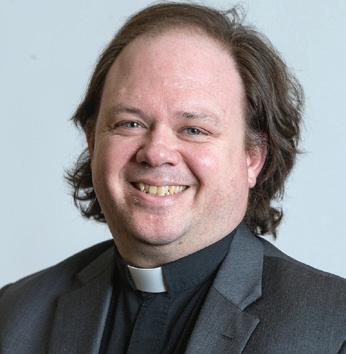
I am put in mind of this dynamic as I reflect upon Michael S. Ariens’s recently published The Lawyer’s Conscience: A History of American Lawyer Ethics. Ariens surveys the history of how lawyers imagined themselves and how competing images have been synthesized into a multifaceted, perhaps self-contradictory conception of the modern lawyer. Throughout this survey, from the eve of the American Revolution to the crises of the early 21st century, the core tension has always revolved around this same dynamic: what is the vocation of the lawyer, and, thus, what is the lawyer’s mission, and how does any of this define the lawyer’s profession?
Leave any group of lawyers alone for long enough, and they will inevitably begin reflecting amongst themselves on the nature of “the profession” (idle hands, devil’s workshops, and all that). Some will reflect wistfully on an earlier era of civility or professionalism, which may or may not have ever actually existed. Others will focus on how to leverage modern trends to better serve clients or their own interests. A particularly enterprising few will form a committee or even a commission, pushing forward the collective sense of identity and mission. None of this is inherently bad or wrong. It reflects, ultimately, a sense, nurtured from admission to law school through the passing of the bar and into practice, that the legal profession is distinct in some way from many other professions, even other “learned” professions. What sets lawyers apart is not that they have studied for many years (health care professionals or university academics often have far longer courses of study) or that their fields are particularly more complex than others. (Most professions appear obtuse and byzantine to those who do not understand their methodologies and jargons.) Rather, lawyers are set apart by the type of work in which they engage, work that is fundamentally political not in the sense of partisan debates, but in that it is fundamentally tied into the ways we live together as a community, as a nation, as a people.
Even cursory familiarity with the legal system demonstrates that this is not purely professional ego. Much of our common life in the United
40 MARQUETTE LAWYER SUMMER 2023
THE BEST INTERESTS OF CLIENT AND “KING”
Nathaniel Romano, S.J.
States depends upon legal professionals and the systems they operate and operate in. We could, of course, look at the work of the Supreme Court, which regularly renders determinative decisions on major questions in our public life. But even beyond the high politics of the Court, the role of lawyers in how we live together is evident. When marriages break down, it is lawyers and judges who aid spouses and parents in making (or at least attempting to make) equitable divisions of property and assets as well as fair arrangements for the care, custody, and support of minor children. Disputes with neighbors, employers, and even strangers are resolved through civil or criminal systems managed by lawyers. Anticipating the end of life, we rely on lawyers to settle our affairs for both dying and beyond, through wills, powers of attorney, and other forms of estate planning. The examples can continue. Daily enmeshed in these decisions, lawyers are aware of the role they can play in how we live and how we live together. And so, they are regularly concerned with “the profession”—what it means to be a lawyer.
We can see this clearly in the Model Rules of Professional Conduct published by the American Bar Association (ABA). The Model Rules, versions or adaptations of which have been adopted by nearly every American jurisdiction, not only set
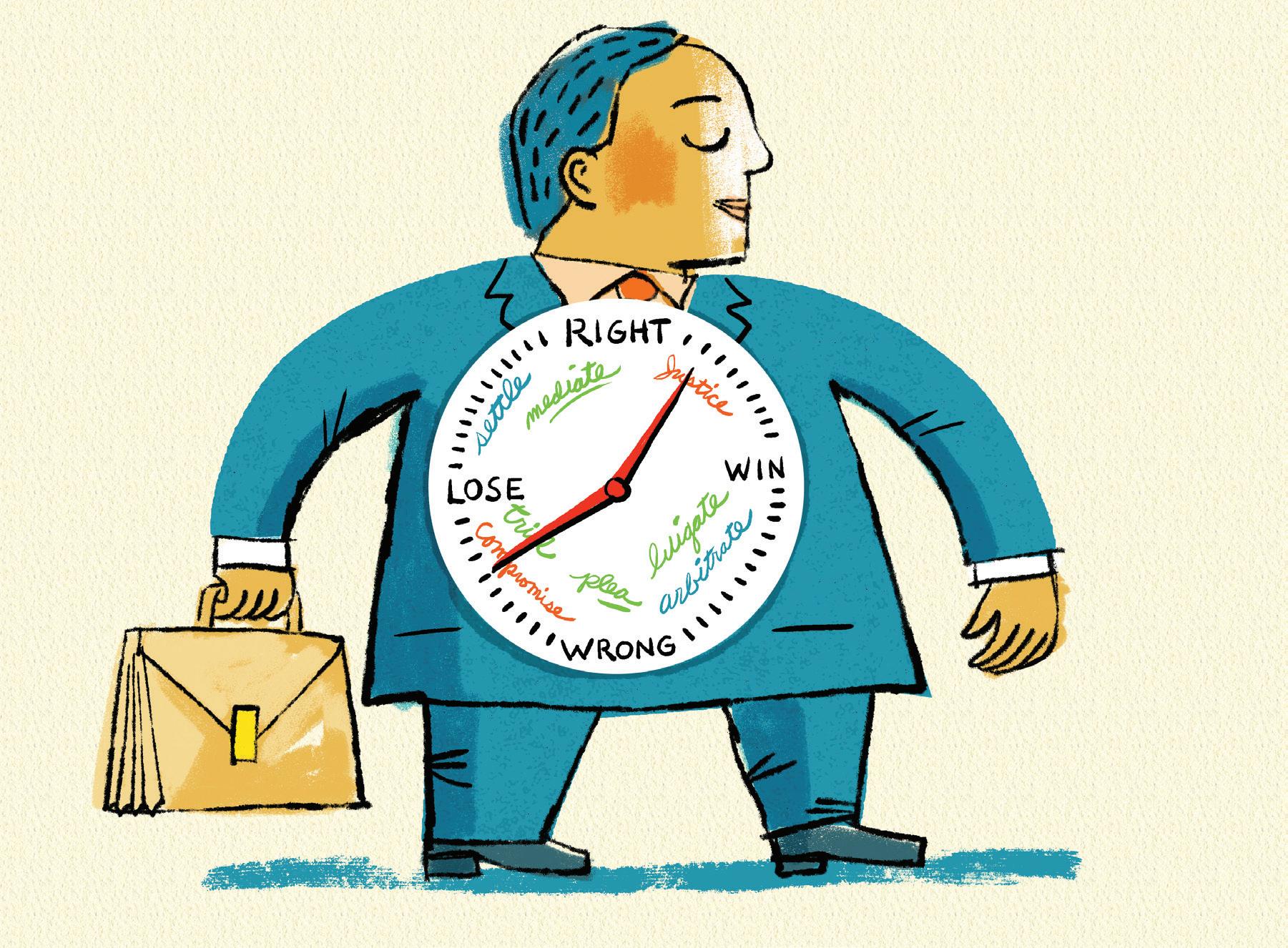
out standards of behavior and professionalism for lawyers, but also proclaim a vision or model of what a “good lawyer” is. These rules begin with a “Preamble” which, while not binding in the sense the rules proper may be, clearly sets out this model. “A lawyer,” the very first sentence declares, “as a member of the legal profession, is a representative of clients, an officer of the legal system and a public citizen having special responsibility for the quality of justice.” Thus, we see that, for the ABA at least, the lawyer is not simply a technocratic legal specialist, nor simply an agent of the client’s will, but a “public citizen” bearing some measure of responsibility for the common weal. The balance of the preamble attempts to explain what each of these phrases means, particularly its conception of the lawyer as a public citizen. The lawyer’s obligations are beyond simply obtaining the best outcome for a client; they extend to making the legal system function for all of society’s members, including those unable to afford the lawyer’s services at the usual rates, and building up the institutions of our constitutional democracy.
Nathaniel Romano, S.J., is assistant director of campus ministry for liturgical programs and adjunct professor of law at Marquette University. The full post is available on the Marquette Law School Faculty Blog (February 15, 2023).
Rather, lawyers are set apart by the type of work in which they engage, work that is fundamentally political not in the sense of partisan debates, but in that it is fundamentally tied into the ways we live together as a community, as a nation, as a people.
41 SUMMER 2023 MARQUETTE LAWYER
“AN ETHICAL PERSPECTIVE UPON THE CURRENT STATE OF THE LAW OF LAWYER ADVERTISING” — A LOOK BACK
The final entry in this series inspired by Michael Ariens’s new book—The Lawyer’s Conscience: A History of American Lawyer Ethics—is drawn from the past. Robert F. Boden, L’52, was dean of Marquette Law School during Ariens’s time as a student. Boden taught and wrote about legal ethics, and the following excerpt from one of his articles provides a close-in-time perspective on Bates v. State Bar of Arizona, the landmark 1977 decision of the Supreme Court of the United States concerning the First Amendment. Boden’s article—FiveYears After Bates: Lawyer Advertising in Legal and Ethical Perspective—appears at 65 Marq. L. Rev. 547 (1982). The following is section IX of the article, with footnotes omitted.
Robert F. Boden

The profession has suffered over the past 19 years from a long line of constitutional decisions about lawyer advertising and solicitation. This is not to judge that those decisions were wrong or unnecessary, but only to assert that this series of developments has left many lawyers of good will and good faith wondering whether the underpinnings of professionalism were being knocked out from under the American bar in the name of the constitutional rights of clients and some colleagues. There is no reason for any lawyer to fear that these constitutional decisions, or the changes in the rules brought about as a result of these decisions, have adversely affected lawyers’ ethics as that term ought to be understood.
We have for a long time confused the law governing the manner in which we practice with the principles of ethics. Perhaps this is the natural result of the legal positivism which has pervaded legal education and the practice for a good portion of the 20th century. The 1908 Code, while not expressly declaring itself to be a set of ethical principles, was nevertheless denominated Canons of Professional Ethics, and in time came to be regarded as a statement of principle rather than of law. The word ethics was taken out of the 1969 Code, and an effort was made in its text to
differentiate between “ethical considerations” and “disciplinary rules.” However, these rules were denominated thus in the past, and for that reason, lawyers have come to think of the rules of the prevailing code as the principles of ethics. The Kutak Commission, by attempting to rewrite a code for the American Bar Association in the 1980s, is trying (perhaps too hard) to write a set of rules which will be merely rules of professional conduct.
The job of the American lawyer, facing the incursions of constitutional law into his old set of rules as well as the efforts of the Kutak Commission to write ethical considerations out of the new Code, is to realize and understand that the body of doctrine under which we have been operating, whether the 1908 version or the 1969 version, was a “mixed bag.” Of course there are principles of ethics to be found in the old and the present Code, as well as in anything being offered by the Kutak Commission. But a great deal of what appears in those codes in “black letter” rules represents legislation that is morally indifferent. The rules of advertising, or such of them as remain, need to be distinguished from principles of ethics relating to advertising by lawyers. We can no longer disguise all of those rules as principles of ethics. The Supreme Court itself recognized this in Bates, saying:
It appears that the ban on advertising originated as a rule of etiquette and not as a rule of ethics. Early lawyers in Great Britain viewed the law as a form of public service, rather than as a means of earning a living, and they looked down on “trade” as unseemly . . . . Eventually, the attitude toward advertising fostered by this view evolved into an aspect of the ethics of the profession . . . . But habit and tradition are not in themselves an adequate answer to a constitutional challenge. In this day, we do not belittle the person who earns his living by the strength of his arm or the force of his mind. Since the belief that lawyers are somehow “above” trade has become an anachronism, the historical foundation for the advertising restraint has crumbled.
42 MARQUETTE LAWYER SUMMER 2023
THE BEST INTERESTS OF CLIENT AND “KING”
The rules declared unconstitutional by the U.S. Supreme Court in Bates v. State Bar of Arizona (1977) and In re R.M.J. (1982) were not, by virtue of placement in a code of professional responsibility, made into principles of ethics. Bates and R.M.J. have left our professional regulation of the morals of advertising quite intact, probably stronger, and certainly more visible than heretofore. Until recently that regulation was barnacled over by more than 70 years of attempts to define “habit and tradition.” Consider the Court’s summation in R.M.J. of the current state of the law: Commercial speech doctrine, in the context of advertising for professional services, may be summarized generally as follows: Truthful advertising related to lawful activities is entitled to the protections of the First Amendment. But when the particular content or method of the advertising suggests that it is inherently misleading or when experience has proven that in fact such advertising is subject to abuse, the states may impose appropriate restrictions. Misleading advertising may be prohibited entirely. But the states may not place an absolute prohibition on certain types of potentially misleading advertising, e.g., a listing of areas of practice, if the information also may be presented in a way that is not deceptive. . . . Although the potential for deception and confusion is particularly strong in the context of advertising professional services, restrictions upon such advertising may be no broader than reasonably necessary to prevent the deception. Those are not the words of a court attempting to subvert moral or ethical principle in order
to extend constitutional protection to a form of speech. They are words which enshrine the true moral principle in a constitutional doctrine and extend its protection to our efforts at preventing misleading or deceptive advertising. The ancient injunction, expressed in the Judeo-Christian tradition as “Thou shalt not bear false witness,” not only remains intact but emerges, when applied to lawyer advertising, with a constitutional stamp of approval.
In this, as in all things pertaining to changes rapidly occurring in the profession and to the criticism and clamor which swirl about it, we must individually devise plans which will preserve our pride in being lawyers and our devotion to professional ideals. This may have been easier for our predecessors than it is for those of us who live and practice in the 1980s. We must not let the stripping away of some of the trappings of professionalism, as we were used to them, lead us to despair or to the conclusion that professionalism has been lost. Observing the wreckage of the elaborate system devised over the past 75 years to regulate in detail the subject of advertising, there is a greater danger in this, than in other areas of change, that some who revere the professional image of the lawyer and whose support is essential to continue it, may lose faith. This cannot be allowed to happen. The legal profession can no more afford the loss of professional idealists because of a change to morally indifferent rules regulating advertising than the Catholic Church could afford to lose a large segment of the faithful because of the change in the time-honored rules of fast and abstinence.
In this, as in all things pertaining to changes rapidly occurring in the profession and to the criticism and clamor which swirl about it, we must individually devise plans which will preserve our pride in being lawyers and our devotion to professional ideals.
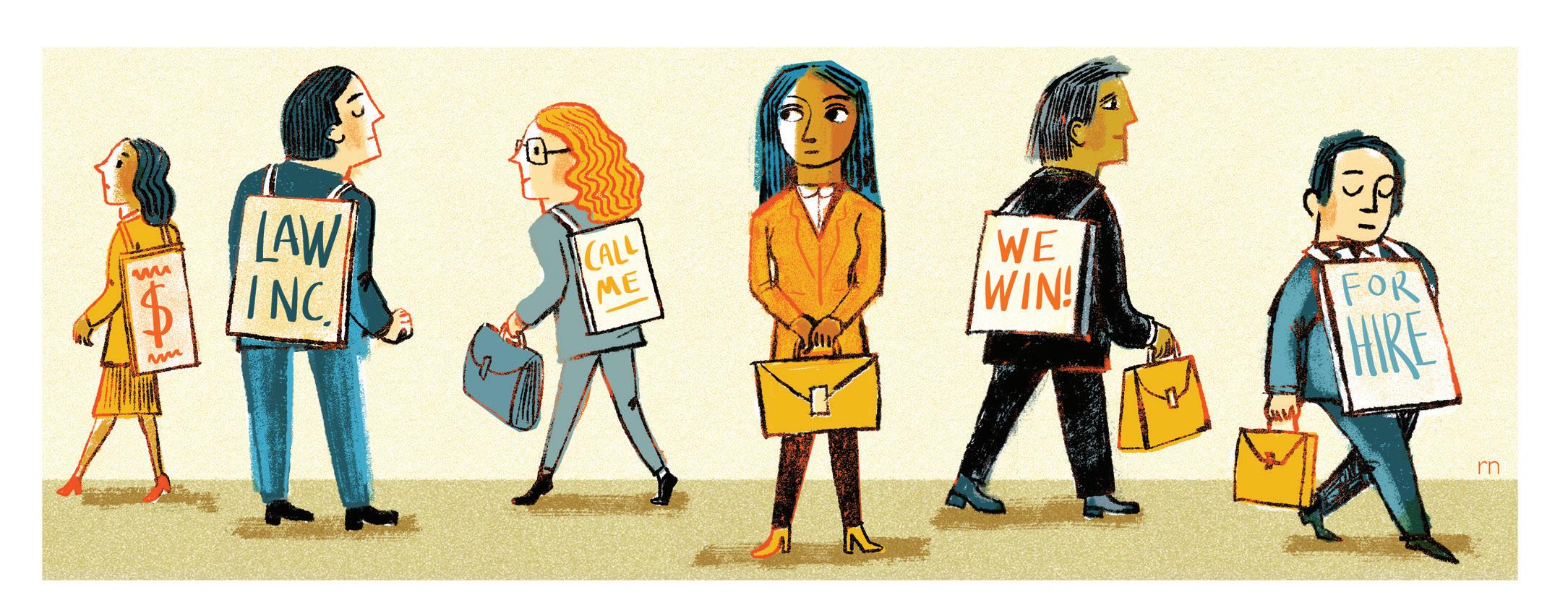
43 SUMMER 2023 MARQUETTE LAWYER
Unretiring Thoughts from a Retiring Criminal Defense Lawyer
How Healthy Is the Rule of Law?
Ellen Henak’s career as a lawyer began literally with a splash of mud. Now, as she is ending a distinguished career specializing in criminal defense appellate work, she worries that such work is getting splashed with mud, figuratively speaking. Her critique is measured but forthright.
She remains committed to the values of her work and does not regret her career path. But one factor in her decision to retire was that “the developments in the law were starting to make me doubt whether there really was a rule of law.”
Henak didn’t plan on being a criminal defense attorney in Wisconsin. But she ended up as a public defender in Milwaukee before joining her husband, Robert, also a well-known defense lawyer, in the Henak Law Office. Among the other ways she has served the legal profession is as a long-time adjunct professor at Marquette Law School, teaching appellate advocacy.
As she heads into retirement—she is no longer teaching as an adjunct professor, but finishing work on her cases is a more gradual process— Henak sat down with the Marquette Lawyer for a sort of “exit interview.” The conversation ranged over her career and how she believes the legal system has changed. Let’s start at the beginning, if briefly.
Entering the Profession and Coming to Wisconsin
In one of the pivotal “accidents” in her career, Henak applied in 1983 to be a clerk for a justice of the New Jersey Supreme Court, after graduating from the New York University School of Law. She was scheduled for a job interview with the justice at his home office.
“He forgot I was coming,” Henak said. “I had gotten off the train in Morristown, New Jersey, and
a big truck promptly went by, completely splattering me with mud. It didn’t matter that I had an umbrella, because it came up the other direction.
“So I show up at his house. He’s leaving to go to the grocery store, and I’m standing there, drenched and full of mud. I had kind of gone, ‘Oh, well, I’m not getting this job.’ I have no idea what I ended up saying to him because I had written it off completely. And I didn’t get that job, but when a new justice came, the first justice handed my résumé to her.” And Henak was hired.
After the clerkship ended, she looked for positions in New York City. Her goal was to work in litigation. She interviewed with the City of New York. “They wanted me to do their more corporate/transactional type stuff,” Henak said. “When I interviewed, I had a cold, and I’m a Midwesterner. This came across as me being not aggressive enough for litigation. But they did want to hire me. So they called me back. Here we go accidental again. My father and I came up with this strategy. I came in for a second interview, we had a nice little chat, and I said, ‘Look, what I want to do is litigation, and if you don’t want to give me litigation, I’m not interested.’ And I got up and began to walk out. Long story short: I got the litigation job.”
She and Rob met in law school and married. “He had always wanted to do criminal law, so he was working for Legal Aid in New York City, which is their equivalent of the public defender. At that point, we had him doing criminal law and me defending cops.
“But he’s a rural boy,” Henak said. “New York was not the place for him. So after we got married and had a kid on the way, I said ‘okay’ to looking elsewhere.” He had clerked for Judge James E. Doyle, a federal district judge in Madison, Wisconsin (father of Wisconsin’s future governor, James E. Doyle, Jr.).
44 MARQUETTE LAWYER SUMMER 2023
An opening came up for Rob at a well-known Milwaukee criminal defense firm, Shellow, Shellow & Glynn. Ellen Henak said, “We decided that since I was going to have a baby then anyway, we’d just move, and I would find a job afterward. I eventually did. At one point, I was doing overflow work for Shellow, Shellow & Glynn, which kind of slid me into criminal appeals because that was what Rob was doing.
“I realized it was a good fit,” Henak said. “I liked the kind of thoughtfulness it allowed for.” She also found that she was comfortable with the clients. Before going to law school, she was a special education teacher. “I’m actually not surprised that, coming out of special ed, I found there were a lot of learning disabilities among the clients—not always, but often—and I found that actually my special education background was an advantage. I could pick up certain psychological reports or that kind of thing and see things that a lot of the attorneys with a different background were not seeing.”
Finding the Public Defender’s Office
Her next career turn came in 1991: “There was an opening for a half-time job at the public defender’s office, which I ended up snagging. I’m sure that they were fine with my legal skills, but there was something else in my background they wanted, which was they were just computerizing. When I went to high school, my high school was ahead, and I had done programming. My hobby at that time was doing some programming, some computer stuff.

45 SUMMER 2023 MARQUETTE LAWYER
“I’m not a big fan of electing judges. My reason is less about whom we get as judges and more about what it does to the conversation.”
— Ellen Henak
“That was a very good fit for me for a very, very long time,” Henak said. “It started as half-time. When my youngest was going into kindergarten, there was an opportunity to go three-quarters time, and that is what I did. . . . What I liked about that was that it allowed me to do two things that a lot of public defenders don’t have the luxury to do.” One was that, with family members of defendants, “I had time to listen, and I realized very quickly that when you don’t have that time, there are pieces that get missed. . . .
“The other thing it allowed me to do was a little bit more [for clients]. With criminal appeals, you don’t win very often. . . . You can do a certain amount of—I think, for lack of a better term—social work, and sometimes that’s the most important part. Sometimes that has much more of an impact on somebody’s life.” Henak elaborated: “It allowed me to do, and I’ve continued to do, things like help the [client in prison] who calls and says his dad just died and whom in the prison should he talk to. Most of the public defenders would have been able to tell somebody whom to contact, but I could take the time to sometimes pick up that phone and ease it through.”
Why did she leave her public defender position? “There were some changes in the public defender’s office,” she said. The office had grown greatly in her time there. “Part of growing, with any institution, is that it tends to harden lines of authority and it tends to regularize some things.” That meant some changes in how she was expected to work. “And there was a tendency for one-size-fits-all rules to come down.”
Doubts About the Fairness of the System
But there was more to her decision to leave the public defender’s office and join Rob’s firm.
Henak was working frequently on cases involving Wisconsin’s law known as Chapter 980. The law allows people convicted of violent sexual crimes who served their full sentences to be confined indefinitely as potential threats to people. “I am not and have never been convinced of this whole premise that, on the one hand, we can hold somebody criminally responsible [and thus incarcerate them] because they understood their actions,” she said, and “then we turn around and say, on the other hand, that those same actions meant that they couldn’t control themselves—so we’re committing them [after their sentence is completed]. To me, there’s a disconnect there.“
In addition, Henak was concerned about the factors involved in deciding if someone should be committed and remain locked up. “The whole premise of 980 law just felt like a misuse of science to me,” Henak said. “I looked at some of what passed for the psychology and science in the area. It never felt soundly based to me. One day, the fact that my client did one thing would mean that, of course, they are a predator; and the next day, the fact that they did the opposite would mean, of course, they’re a predator. There was a lot of that.
“The bigger problem with the 980s was that when it was ruled constitutional, the Wisconsin Supreme Court said, well, it’s barely constitutional, but it’s okay because it does A, B, C, D, E (let’s pass over what the specifics are). Over the next ten years, we eliminated A, we eliminated B, we eliminated C, we eliminated D as protections, and we eliminated E. Yet we said ‘no problem.’
“Part of me says: what do you mean by a rule of law when you allow this?”
Henak described where the law led for one of her clients. Even though he had completed his sentence, it took an additional 13 years to bring him to a civil trial on whether to continue to confine him. He was committed and locked up the entire time. Eventually, he was released.
The Shortage of Defense Lawyers
Henak said that not many lawyers in Wisconsin are doing post-conviction work, at least after the first direct appeal. There are a number of reasons for this, she explained. One reason is that it can be very hard to make money at it, she said. Others include the discomfort of lawyers with prevailing so rarely and the fact that the procedures in the cases are different from other litigation and are highly technical.
Henak added, “Honestly, at this point, I still do criminal law because somebody has to. Do I believe that there’s really a rule of law going on? No, I do not.”
Does she think that that strong statement has become more true or less true in recent years?
“I think it has become more true, and I think it is for a couple of reasons, none of which I think bode well for the future. I’m not a big fan of electing judges. My reason is less about whom we get as judges and more about what it does to the conversation. And you see it in the current Wisconsin Supreme Court election. Candidates
46 MARQUETTE LAWYER SUMMER 2023
UNRETIRING THOUGHTS ON THE RULE OF LAW
start running on all sorts of things that are not about rule of law. . . .
“As we’ve seen more and more money go into our judicial races (and now it’s come down from not just the supreme court race, we are now seeing it in circuit court races, we are seeing it in court of appeals races), they do not take the time to explain to people what the judges are doing a good deal of the time—which is not criminal law.” For campaign themes, “It’s just lock them up. And that has become the standard.
“Put that together with the lack of resources in the criminal justice system. . . . Systems tend to end up valuing what they measure. What do we measure in the criminal justice system? How many convictions. Not ‘Were they the right convictions?’ But ‘How many convictions, and how quickly did we process the cases?’”
Respect for the work of defense attorneys has also declined. “[Criminal defense attorneys] will get yelled at by absolutely everybody. You have to have a certain kind of personality. I come from a family of eccentrics, so I’m not that geared to what other people think most of the time. . . . My dad was going to skip down the street with his briefcase no matter what I did.
“But you [as a defense attorney] are the person that everybody can afford to yell at. The client can afford to yell at you. Whether you’re private pay or public defender, for the most part, you’re stuck with that client because you have to ask the court to get out most of the time, and the courts don’t like to do that. They feel that it just passes the problem along.
“And the judges can afford to yell at you if they’re frustrated. They do not yell, for the most part, at prosecutors in the same way, partly because a lot of them come out of those offices— those are their friends.”
A “No Harm, No Foul” Standard for Appeals
What about the law itself? Asked for a leading example of her concern, Henak said that the Wisconsin Supreme Court is making it harder and harder to establish on appeal that an erroneous ruling at trial was prejudicial error, as compared to harmless error.
“One of the things that’s been happening is that, if there was a mistake,” the rule was “no harm, no foul.” But what is harm? “What it’s supposed to be is that there’s a reasonable probability of a different result—not that the jury would have come
out differently, but that this is important enough that we can see a good chance that they would have. Well, it used to be that you [the appellate courts] looked at the evidence and said, ‘Is this a major piece of evidence?’ If I could convince the court this was a major piece of evidence that either came in and shouldn’t have or didn’t come in and should have, the courts would say, ‘Well, we’re not the jury. A reasonable jury could hear this, and we really ought to send this back.’”
Henak pointed to a recent ruling by the Wisconsin Supreme Court that, in her view, amounted to saying, “Why does it matter since the defendant was probably guilty anyway?”
As for the standard applied to ensure that attorneys representing people in criminal proceedings are providing effective assistance of counsel: “We’re getting very close to ruling that if the body [of the attorney] is breathing next to you [the defendant], if that attorney is sitting there and breathing, it’s okay.”
Henak agreed that an underlying theme in her views was the increasing politicization of the system and increasing pressure on the system, especially prosecutors and judges, to take into account popular sentiment. “I’m glad that politicians and others at least give lip service to the idea that we should have representation of everyone, because the day we stop giving lip service is the day we stop even feeling like it’s important,” Henak said.
What’s the future for this sector of the profession in Wisconsin? “Rob and I have a policy that we will take any phone call that comes. We may have to tell somebody we can’t help them, but we used to take collect phone calls from the prisons, regularly. We take letters; we answer every letter that comes. I don’t know who’s going to do that when we’re gone because it used to be us and Howard Eisenberg.”
Has she thought about whether getting splashed with mud as she went for her first job interview was a metaphor for things that have happened during her career?
“I have. I actually have.”
Yet would she do it again? “Yes. Yes.”
47 SUMMER 2023 MARQUETTE LAWYER
“Systems tend to end up valuing what they measure. What do we measure in the criminal justice system?” — Ellen Henak
THE RISE AND IMPACT OF CORPORATE LANDLORDS
Big Investors Nationwide Are Increasingly Seeking Profits from Low-Cost Houses in Milwaukee, with Consequences for Residents
by John D. Johnson
The Great Recession had many lasting effects, including the phenomenon in which corporate landlords operate enormous numbers of single-family (or duplex) rental properties. Rentable houses aren’t new, but, before the subprime-mortgage crisis, nearly all of them in Milwaukee, and to a large degree nationwide, were owned by small local landlords. Large corporate landlords were common in the apartment sector, but the prevailing view held that acquiring and managing a scattered portfolio of single-tenant rentals just wasn’t feasible for institutional investors at scale.
That all changed around 2010, thanks to the foreclosure crisis. Massive inventory, artificially low prices, and
federal government policies combined with technological advances to change the conventional wisdom about the home rental market. A set of large companies began assembling massive portfolios of single-family rentals (SFRs) at an unprecedented pace, using capital raised in private equity markets. Cumulative institutional SFR holdings grew from a negligible amount at the beginning of 2012 to more than 100,000 nationwide by the end of 2013. By 2022, an industry estimate placed institutional ownership at 700,000 single-family rentals, with extraordinary projected growth: to 7.6 million by the end of the decade.
The pioneering wave of institutional investment involved only a handful of companies, operating in a specific slice of American cities. The first investors focused on the Sunbelt. They picked metros with growing populations (to improve demand) and newer housing stock (likely to avoid lead paint exposure). They sought tenants from the growing ranks of middle-class renters who sought housing in good school districts with low crime rates. To achieve economies of scale, each
company aimed to purchase hundreds or thousands of houses in any market it entered. By 2015, the SFR market shares of private-equity-backed landlords were largest in Phoenix, Atlanta, Tampa, Houston, and Las Vegas, according to an analysis of records collected by the real estate data firm CoreLogic.
These companies mostly ignored the Rust Belt, and they entirely avoided Milwaukee. But none of that stopped another set of outside investors— individual buyers, mostly—from pouring into the city and buying thousands of properties previously owned by homeowners. These buyers understood something that the larger, more notorious Sunbelt investors may have missed. Milwaukee’s houses are cheap, and rents are, comparatively speaking, quite high. Evidence is mounting that profits from rent are often highest in the poorest neighborhoods of the poorest cities. In any event, outside investors came to Milwaukee.

The first wave of landlord acquisitions in the early 2010s involved houses previously owned by distressed owner-occupiers who had gotten caught up in the foreclosure crisis. While institutional investors played a large role in Sunbelt metros, most such purchases in Milwaukee were made by small to midsized investors.
The latest wave of private equity acquisitions is different. At the end of the 2010s, a new set of private-equitybacked companies apparently realized the profitable potential of Rust Belt rental markets. They rapidly began expanding to Milwaukee and other postindustrial cities with similarly
48 MARQUETTE LAWYER SUMMER 2023
cheap housing and unrobust population growth. The largest of these, VineBrook Homes, was incorporated in 2018 and now owns more than 27,000 homes across markets such as Milwaukee, Cincinnati, St. Louis, Indianapolis, and Kansas City. Rather than buying properties out of foreclosure (or from a flipper), these companies are most frequently consolidating the portfolios of the smaller landlords who came before them.
Housing policy is the subject of intense national interest, but little of that has focused on the specific situations of Rust Belt cities with old housing stock and scarcely any population growth. As the Chicago-area planner and writer Pete Saunders put it, “Urbanism debates [have] for some time been led by people whose experience has come in the knowledge economy-driven coastal cities, or lifestyle and affordability-driven cities of the South and interior West. Their issues have become national issues.”
This article lays out the facts in Milwaukee—how the housing crisis played out in a deeply segregated postindustrial city with no population growth—and the consequences for homebuyers and tenants alike.

Collapsing Homeownership, 2005–2018
High rates of homeownership have long been a defining trait of Milwaukee. In 2005, nine in ten of Milwaukee’s single-family homes were owneroccupied, compared to 79 percent in the country overall. But the housing crisis of the Great Recession hit Milwaukee twice as hard and lasted several years longer. Nationally, owner-occupancy of singlefamily homes fell about 5 percentage points, bottoming out at 74 percent in 2014. The slide lasted into 2018 in Milwaukee, when owner-occupancy hit a low of 78 percent of single-family homes—a drop of 12 points.
Condos, duplexes, and triplexes all saw similar declines. In total, the city lost 15,000 owner-occupiers (in net), about 12 percent of all houses. By 2018, just 68 percent of the city’s houses (including condos, duplexes, and triplexes and thus a broader category than SFRs) were owner-occupied, down from 80 percent before the crisis. Owner-occupancy fell across the city, but the decline was concentrated along racial lines. In majority-Black areas, 10,000 houses exited owner-occupancy, 16 percent of
the total in these neighborhoods. By contrast, majority non-Hispanic white neighborhoods saw a 5-point loss. Across the northern fifth of the city, more than one in five houses left owner-occupancy— quadruple the national trend.
Faced with a wave of foreclosures, one option for Rust Belt cities was widespread abandonment of houses, but this, fortunately, did not happen to Milwaukee. The comparison with Detroit is instructive. Over the 2010s, about 12 percent of housing units in Wayne County, Michigan, were empty and not available to buy or rent, compared with 5 percent before the crisis. Things were never so dire in Milwaukee County, where 5 percent of houses were empty and off the market during the 2010s, only slightly up from 3 percent before the crisis.
Instead, investors poured into the Milwaukee housing market, recognizing an opportunity to buy low as prices collapsed. Parcel records indicate that city-based landlords added close to 4,600 more properties from 2005 to 2018, a 27 percent increase. Suburban landlords added 5,500 city properties (72 percent up), and landlords from elsewhere
John D. Johnson is research fellow at Marquette Law School’s Lubar Center for Public Policy Research and Civic Education. This article expands on several years of research into Milwaukee’s housing market by Johnson together with Mike Gousha, senior advisor in law and public policy at Marquette Law School. Their previous work on this subject has appeared in a variety of forms, including a series of extensive op-ed pieces in the Milwaukee Journal Sentinel. A post on Marquette Law School’s faculty blog, dated May 15, 2023, provides references to various studies mentioned in this article.
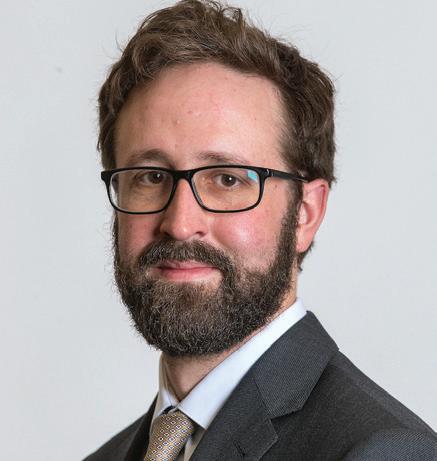
49 SUMMER 2023 MARQUETTE LAWYER
in Wisconsin grew their Milwaukee holdings by 1,300, or 132 percent.
But the largest proportional increase—Milwaukee’s biggest change from past trends—came in the surge of out-of-state investment. Landlords using addresses based entirely outside of Wisconsin quadrupled their collective portfolios, adding 4,000 more rental houses by 2018. At that point, this market remained mostly diffuse, with only a handful of companies owning more than a few dozen properties. The most common sources of out-of-state investors were Illinois (particularly the Chicago metro), California, Florida, and Texas.
Due to their small size and distance from the Milwaukee market, these buyers relied on local property management companies to carry out physical operations. Many such companies operate in the Milwaukee market, and their websites often explicitly cater to this variety of smaller, hands-off investor. The archives of real estate investment web forums and podcasts include many conversations about the Milwaukee market. In a typical example—an interview with a California-based investor—the host observes, “You’re investing at a distance, in Wisconsin. It might as well be overseas, right?”
The appeal is easy to understand. From 2005 to 2012, the typical sale price in the city fell by 28 percent. Meanwhile, rents rose by 15 percent. Even while home values fell, median rents grew at least slightly every year. A local realtor, Alex Segal, described the market succinctly: “What we’re seeing here are people from the coasts and even Chicago coming in. The cost of housing is a lot less here, and the rents are good. The rents make it work.”
The Appeal of Investing in Poor Neighborhoods
Accumulating evidence suggests that profits from rent are actually highest in poor neighborhoods. The basic facts are that rents for cheap houses are only slightly lower than rents for much more expensive properties. We studied this in Milwaukee in 2020, when the
average rented house was assessed around $80,000 citywide and less than $40,000 in some neighborhoods. If a house was worth less than $100,000, the correlation between rent and home value was remarkably small. Typical rent for a $40,000 single-family home was only about 10 percent cheaper than rent for an $80,000 house.
Of course, expenses must be proportionally higher for cheaper properties as well. A new roof costs the same, regardless of the home’s value, and poor tenants are more likely to miss rent. Several recent studies have attempted to measure landlord profits, taking expenses into account.
In a 2018 article in the American Journal of Sociology, Matthew Desmond and Nathan Wilmers measured rents as a proportion of home values. In Milwaukee, they found that it would take 10 years for rent to total the value of a property in low-poverty neighborhoods, but only four years for total rent to equal the value of a property in high-poverty neighborhoods. Segregation plays a role. Even controlling for poverty rates, in both the Milwaukee and national data, rents grew as a fraction of home values as the Black share of the population increased.
Using landlord survey responses and administrative records, Desmond and Wilmers accounted for routine expenses, standard maintenance, and less frequent large repairs. They concluded, “Across the United States, landlords operating in poor neighborhoods enjoy median profits double those of landlords operating in affluent neighborhoods.” In Milwaukee, the gap was even greater: “[T]he median rental unit located in a poor neighborhood produces a monthly profit of $151, after all expenses, while those in nonpoor neighborhoods, owing to large mortgage payments, make $21.”
While the Desmond and Wilmers study relied mostly on survey data, the economists Andrew Demers and Andrea Eisfeldt recently estimated rental income and expenses using a proprietary nationwide dataset of 11 million singlefamily rentals. With their different
methodology and data source, they, too, concluded that profits increased substantially as neighborhoods grew cheaper.
If rental properties can generate so much profit in the poor neighborhoods of cities like Milwaukee, why haven’t more companies gotten in on the action?
Desmond and Wilmers hypothesize that a combination of factors are at play, including an inaccurate perception of high business risks and a fear of reputational costs for being seen as profiting off the poor.
Out-of-state investors have solved both of these problems for themselves. Reliable, granular data about rents, expenses, and property values have never been easier to come by, so investors are able to make their decisions with unprecedented clarity even when living far away from the city in question. That distance also mitigates the consequences of any negative reputation they might develop. In some cases, small out-of-state investors never laid eyes on the Milwaukee houses they purchased, but they were at least aware that they owned them and that real humans either did or did not pay the rent.
Recently, several large private-equitybacked landlords have finally discovered the profitable potential of the Milwaukee rental market. These companies raise capital by selling securities to shareholders. In this way, the ultimate owners of an increasing share of Milwaukee rental properties need never even be aware of what they own, or of the business decisions made on their behalf, in any specific way.
Competition for Affordable Homes, 2019–2022
The late 2010s marked an inflection point in Milwaukee’s housing market. Beginning in 2019, owner-occupancy started to recover. Around the same time, the holdings of local landlords began to dwindle. Out-of-state purchasing continued to grow as quickly as ever, but the nature of the buyers and sellers in those transactions changed in important ways.
By the end of a four-year period, in
50 MARQUETTE LAWYER SUMMER 2023 THE RISE AND IMPACT OF CORPORATE LANDLORDS
Change in owner-occupied houses vs. out-of-state-owned houses
In the 10th district, for example, owneroccupancy increased by 274 houses, while the number of houses owned by out-of-state landlords grew by 121.
2022, the city enjoyed a net increase of 3,000 new homeowners, equivalent to 2 percent of the housing stock. Although this recovery pales in comparison to the 13 straight years of losses preceding it, it still represents a real, positive change sustained across multiple consecutive years in almost every part of the city.
Around the same time, the number of properties owned by local landlords began to decline. Since 2018, city and suburban landlords, combined, sold about 4,300 properties in Milwaukee. Landlords headquartered outside Wisconsin added about 2,000.
Landlords built their portfolios during the foreclosure crisis by acquiring previously owner-occupied properties, sometimes with a bundler or flipper in between. How, then, did out-of-state landlords continue to expand at a rapid pace even while owner-occupancy began to recover? Whom did each type of buyer purchase from?
We answered these questions by matching transaction records with parcel data—that is, real estate transaction returns filed in the state revenue department with parcel ownership records maintained by the city assessor—and coding the ownership status of each property before and
after every sale. Considering just arm’slength transactions in 2019–2022, we found that owner-occupancy increased because homeowners bought both the lion’s share of houses sold by other homeowners (83 percent) and a large fraction of the homes sold by landlords. Owner-occupiers bought 51 percent of houses sold by landlords from the suburbs, 43 percent of those sold by citybased landlords, and 39 percent of those sold by out-of-state owners.
When owner-occupiers sold to a landlord, it was usually one from the Milwaukee metro area. Yet such sales to a landlord were relatively unusual: city-based landlords bought 6 percent of owner-occupier sales, suburban landlords another 7 percent, and out-ofstate landlords just 4 percent.
Out-of-state landlords bought most of their properties from other landlords— particularly local ones. Fifty-five percent of their arm’s-length acquisitions came from a city or suburban landlord, a quarter from another out-of-state landlord, and just 14 percent from an owner-occupier. The pipeline of homeowner to out-of-state investor still exists, but in recent years it has been only a small fraction of out-of-state landlords’ total purchases.
Simultaneously, a Surge of Owner-Occupied Homes
At a citywide level, the recent burst in owner-occupier activity outpaced outof-state investor acquisitions by about a thousand houses, but this obscures large variations between neighborhoods. Net increases in owner-occupancy have occurred across most of the city and at most price points, while recent out-of-state investment has been highly concentrated in low-to-mid-priced homes in majority-Black neighborhoods across Milwaukee’s north side. Consequently, competition between would-be homebuyers and investors has been strong in particular neighborhoods—and altogether absent in others.
The accompanying chart and map (above) compare the increase in homeownership with the increase in out-of-state investment within each of Milwaukee’s 15 aldermanic districts. The two mostly Latino districts, the 8th and 12th, stand out for having the lowest owner-occupancy growth and practically no increase in out-of-state investment. Mainly white districts have all seen larger increases in owner-occupancy, and—with the exception of the 10th district—little or no interest from investors outside
51 SUMMER 2023 MARQUETTE LAWYER
1st 2nd 3rd 4th 5th 6th 7th 8th 9th 10th 11th 12th 13th 14th 15th 1st 10th 11th 12th 13th 14th 15th 2nd 3rd 4th 5th 6th 7th 8th 9th
0 100 200 300 400 0 100 200 300 400 owner-occupancy, net increase outside-Wisconsin landlord, net increas e largest racial or ethnic group Black Hispanic or Latino White In Milwaukee aldermanic districts, 2018 to 2022
Wisconsin. In fact, the total number of houses owned by out-of-state landlords declined slightly in majority-white neighborhoods from 2018 to 2022.
The situation is entirely different in the aldermanic districts where most residents are Black. By the end of 2022, nearly one-in-four rental homes in majority-Black neighborhoods were owned by an out-of-state investor. That’s up from just 15 percent in 2018. Although owner-occupancy grew in all Black-majority districts, out-of-state investment grew faster in most such areas. For instance, the 1st district saw a net increase of 174 owner-occupiers but 455 out-of-state-owned rentals.
The 6th, 7th, and 15th districts together make up the inner core of Milwaukee’s north side—covering some of the most segregated Black neighborhoods in the entire country. They collectively saw an increase of about 700 owner-occupiers, which is just over 2 percent of the housing stock. Outof-state investment grew by more than 1,000 houses over the same period.
A review of transactions records reveals that while some small individual investors remain active, the biggest change since 2018 is the entrance and expansion of three large corporate investors. They are VineBrook Homes, SFR3, and Highgrove Holdings. Highgrove and SFR3 are both based in California. VineBrook is headquartered in Ohio. At the beginning of 2019, these companies owned fewer than 90 houses in Milwaukee. By the end of 2022, they owned nearly 1,500 in aggregate.
Unlike the smaller investors who preceded them, these companies are vertically integrated, meaning that they provide acquisition, maintenance, and management services directly. They raise capital by selling securities to private investors, in addition to any debt they take on. Accredited investors are generally required by the Securities and Exchange Commission to have some combination of high income or net worth. In other words: accredited investors have a similar profile to
the kinds of wealthy individuals who characterized out-of-state investment in the early and mid-2010s. The new institutional investors provide access to profits from Milwaukee’s rental market without requiring the individual investor to take on personal legal exposure or the administrative headaches of hiring a local property manager. The larger companies are also better positioned to increase profits by achieving economies of scale.
This business model is not new—it was pioneered in the early 2010s by firms such as Invitation Homes in the Sunbelt. What is relatively novel is the application of this model to a Rust Belt market such as Milwaukee. On a website for investors, Highgrove Holdings describes Milwaukee’s advantages, including “properties that offer considerable asset appreciation, excellent cash flow above most other areas, and . . . many ‘friendly-to-landlord’ city policies.” Highgrove specifically buys properties in areas covered by the Opportunity Zones Program established by Congress in 2017; this allows significant tax advantages for investors seeking to shelter capital gains. A typical Highgrove rental property is a duplex or triplex worth around $50,000–$60,000.
VineBrook Homes is the largest owner of single-family homes in Milwaukee, with about a thousand properties at the end of 2022. A real estate investment trust (REIT), VineBrook was incorporated in 2018. By December 2022, it owned more than 27,000 homes in total, up from fewer than 17,000 at the beginning of the year. Its cumulative real estate was valued at about $3.6 billion.
Milwaukee is merely a midsized market for VineBrook. It owns even more properties in Cincinnati, Dayton, and Columbus, Ohio; St. Louis and Kansas City, Missouri; Indianapolis; Birmingham, Alabama; Columbia, South Carolina; Jackson, Mississippi; and Memphis.
In filings, VineBrook describes its focus on “large to medium size cities and suburbs located in the midwestern, heartland, and southeastern United States.” Similarly, SFR3 describes itself as
a “tech-enabled real estate fund based in California” operating “throughout the South & Midwest.” In Milwaukee, both SFR3 and VineBrook most commonly buy single-family homes worth around $100,000.
Consequences of Institutional Investment for Aspiring Homeowners
Though still relatively new, institutional investors have operated in the home-rental market long enough for researchers to draw some conclusions about their effect on targeted communities. Their operations have clearly negative consequences for aspiring homeowners in Milwaukee, while the impact on tenants appears more mixed.
Corporate landlords make it harder for local residents to buy homes, even without outbidding them on price. They do this in several ways. Often, they acquire their properties in so-called “off-market” sales. In other words, they like to buy directly from sellers, circumventing the standard process of listing homes individually on a multiple listing service (MLS). Even when buying publicly listed properties, they tend to pay cash and close quickly with minimal contingencies. Increasingly, they buy entire portfolios in bulk purchases from smaller landlords exiting the business. Would-be local homebuyers cannot match the convenience offered by this combination of cash, speed, and scale.
Institutional investors use algorithms and massive datasets to speed up the process of identifying the best deals and making offers on them. SFR3 maintains an “off-market portal” where owners can submit properties for potential sale. The webpage includes examples of recently purchased properties, touting the company’s ability to close swiftly. One example, a modest 1,200-squarefoot home in Missouri reads, “OFFER IN 1 HOUR; CLOSED IN 4 DAYS.”
Large investors generally aren’t outcompeting local residents on price.
52 MARQUETTE LAWYER SUMMER 2023
THE RISE AND IMPACT OF CORPORATE LANDLORDS
They are savvy buyers looking for bargains. In 2022, a suburban Milwaukee landlord sold 23 houses in a single transaction to VineBrook for $3 million. He explained, as reported by Milwaukee Journal Sentinel reporter Talis Shelbourne, that he “likely missed out on another $1 million by not selling the homes individually.” The landlord judged the convenience of selling to VineBrook to make up the difference.
Still, the presence of institutional investors does appear to indirectly drive up prices, particularly among the specific market segment in which they operate. Research published last year by Walter D’Lima and Paul Schultz in the Journal of Real Estate Finance and Economics found that prices increase in neighborhoods with a lot of investor activity. In a traditional housing market, individually owned houses routinely come on the market. When many homes in a neighborhood are owned by longterm buy-to-rent investors, the resulting reduction in supply drives up prices among the remaining properties. The effect is not enormous but is significant. D’Lima and Schultz estimate that, within their study, “over the next year, properties within a quarter mile of a buy-to-rent purchase appreciated by . . . 3.4 percent more than properties located five to ten miles away.”
A variety of studies have also considered the effect of institutional investors on their tenants. Do these companies provide a better, worse, or indistinguishable experience for renters relative to other landlords operating similar properties in the same neighborhoods?
Arguments in favor of corporate landlords include that they sometimes invest more in improving their properties than the landlords they replace and that they
increase options for renters. On the other hand, these companies appear to raise rents faster, file evictions much more aggressively, and minimize human interaction with tenants relative to traditional, local landlords.
It is difficult to overstate how detrimental the worst landlords can be to their neighborhoods. Many researchers, including in Milwaukee, have observed a business strategy called “milking,” in which landlords maximize rents while spending the least amount possible, even refusing to pay taxes and allowing buildings to degrade.
The private-equity-backed investors now operating in Milwaukee’s market clearly maintain their properties much better than these landlords. Across its national portfolio, VineBrook reported spending an average of $25,000 on each property it renovated in 2022. Comparable data are not available for Highgrove or SFR3, but a review of their property listings in Milwaukee shows a similar style of rehab. As buy-torent investors with a large and visible market presence, these companies have incentives to maintain their properties and avoid running afoul of local government.
Researchers nationwide have reached a consensus regarding evictions. Large, corporate landlords—particularly those with private-equity backing—file evictions at significantly higher rates than smaller, more-local landlords operating in the same markets.
Elora Raymond, a professor of urban planning at Georgia Tech, led perhaps the first study of eviction rates in singlefamily rentals to consider variations by landlord type. Using 2015 data from Fulton County, Georgia, the authors concluded, “We find that large corporate
owners of single-family rentals . . . are 68 percent more likely than small landlords to file eviction notices even after controlling for past foreclosure status, property characteristics, tenant characteristics, and neighborhood.” They found that the rate of eviction filings varied widely between large landlords, in a way not explained by standard control variables. “[I]nstitutional investors were between 11 percent and 205 percent more likely to file for eviction than momand-pop firms.”
In a 2022 article published in Social Forces, Henry Gomory analyzed 15 years of property and eviction records in Boston, Massachusetts. Gomory found that the likelihood of filing an eviction increases with a landlord’s size, even when controlling for a host of property and resident attributes. Compared to small landlords, medium-sized ones sought eviction 55 percent more frequently and large ones did so 186 percent more. “Furthermore, when large-scale landlords buy properties from small-scale owners, the filing rates immediately and permanently increase,” he concluded. “For small landlords, filing an eviction is a last resort, taken when they want to remove tenants from the property and accompanied by interpersonal conflict. For large landlords, filing is a routine practice, taken when tenants are late on rent and accompanied by little fanfare.”
Serial filings are especially common in jurisdictions where eviction court is cheap and easy to access. For instance, a 2021 study found that serial eviction filings were over 40 percentage points more common in Charleston, S.C., than in the otherwise similar city of Mobile, Ala., where evictions were more than six times as expensive.
The evidence from Milwaukee squares with various national findings. In 2018, for example, about 40 percent of eviction filings in Milwaukee were part of a serial chain. Using court records from 2016 through the beginning of the pandemic, we found
53 SUMMER 2023 MARQUETTE LAWYER
Corporate landlords make it harder for local residents to buy homes, even without outbidding them on price.
that eviction filings were mainly limited to poor neighborhoods. But within poor neighborhoods, they weren’t strongly correlated with the degree of renter poverty or property attributes. Rather, landlord characteristics were far more statistically predictive of eviction filing rates.
We estimated that apartments in average duplexes located in typical neighborhoods would be the subject of eviction filings at an annual rate of 18 per 1,000 if owned by a Wisconsin-based landlord with fewer than 15 properties. If owned by a similarly sized out-of-state landlord, our model predicted 29 filings per 1,000. If owned by a large landlord with 100 or more properties, predicted filings shot up to 159. We also measured the behavior of “neighborhood landlords,” which we defined as individuals (not LLCs) who owned fewer than 5 properties within half a mile of their home. Given the same conditions, our model predicted these landlords would file at an annual rate of just 6 per 1,000.
Rent-payment-related eviction filings may also be more common among corporate landlords simply because they likely charge more. A growing body of evidence suggests that these investors raise rents more quickly than other kinds of landlords. Certainly, maximizing “cash flow” and attendant revenues for shareholders is an explicit goal of private-equity-backed companies. VineBrook reported a 7.4 percent increase in average monthly rents from 2021 to 2022.
All landlords are motivated to make money, but the financialized nature of large corporate landlords, coupled with their embrace of automated management practices, appears to supercharge this process. A recent ProPublica investigation described how one algorithmic software, named YieldStar, is used by property managers to set rents at particularly high levels. As one customer, a “director of revenue management” for a corporate landlord, put it, “The beauty of YieldStar is that it pushes you to go places that
you wouldn’t have gone if you weren’t using it.” According to another executive, “As a property manager, very few of us would be willing to actually raise rents double digits within a single month by doing it manually.”
Algorithms and other technological innovations don’t just help large landlords acquire properties and set rents. They also help companies automate aspects of property management that were previously done by humans. The geographer Desiree Fields describes a whole suite of “automated landlord” technologies, including online portals for tenantlandlord communication, efforts to shift maintenance responsibilities to renters, employee tracking via mobile applications, and the use of smart-home technology to “monitor their investments and surveil tenants.”
Consequences of “Financialization” on Homeowning
Scholars often describe events since the Great Recession as the “financialization of housing.” Financialization, in the words of the economist Gerald Epstein, “means the increasing role of financial motives, financial markets, financial actors and financial institutions in the operation of the domestic and international economies.”
Before the rise of financialization, there were still plenty of single-family homes and duplexes for rent, and the landlords who owned them behaved in a wide variety of ways—good and ill. But most of those landlords were local. They owned properties in their own community. Besides simply seeking to maximize profit, they were also exposed to a whole range of other incentives, including their reputation, spillover effects on their own neighborhood, and any interpersonal relationships they might develop with their tenants. Most rental profits remained in the local economy.
The flood of foreclosures following the Great Recession enabled the widespread entrance of out-of-state investors into Milwaukee’s residential neighborhoods. The recent wave of acquisitions by private-equity-backed corporations marks a truly new era in Milwaukee’s rental market. Financialized ownership of rental homes is something different from simple “absentee” ownership. In a real way, the ultimate owners of these properties are now shareholders, who themselves have no awareness of the specific properties of which they own an abstract fraction.
From one perspective, there is no problem with this. After all, these kinds of financial innovations in ownership provide capital for improvements in neighborhoods with little local investment. This has happened to some extent in Milwaukee. Proponents also argue that larger firms can create economies of scale, lowering operating costs without reducing quality. It is less clear whether any advantages achieved this way redound to the renters themselves. Research to date suggests that large corporate landlords evict more frequently and raise rents more aggressively than their local counterparts.
One of Milwaukee’s great strengths is the relative affordability of homeownership. In contrast to many American cities, buying a house is a realistic choice for working and lower-middle-class families. Even after including maintenance expenses, local experts agree that owning a $100,000 house is generally far cheaper than renting it. Private-equity-backed landlords make this harder by reducing the supply of affordably priced homes available on the open market. Instead of buying homes themselves, more families find themselves paying their rent to companies with only a business interest in the neighborhoods where they operate.
54 MARQUETTE LAWYER SUMMER 2023
THE RISE AND IMPACT OF CORPORATE LANDLORDS
82 Michael S. Ariens wrote The Lawyer’s Conscience: A History of American Lawyer Ethics, published by the University Press of Kansas. (See feature beginning on p. 34 of this issue.)
86 Andrew B. Small joined Weber Gallagher and practices litigation in the firm’s offices in New York City and Bedminster, N.J.
88
Lynne M. Halbrooks has joined Nichols Liu in Washington, D.C., as a partner.
94 Suzanne D. Strater has retired from the practice of law after working for the federal courts in Chicago for more than two decades.
02 Patrick D. McNally was elected president of Borgelt, Powell, Peterson & Frauen, a Milwaukee law firm specializing in civil litigation defense.
04
Rachel K. Monaco coauthored the chapter, “Peace Building and Systemic Change for Survivors of Sexual Violence and Exploitation: LOTUS’s Untold Stories,” in the textbook Restorative Justice: Promoting Peace and Wellbeing (See also photo on this page.)
John J. Schulze was appointed chair of the board of the Villa of Saint Francis, an assisted-living center in South Milwaukee, Wis.
07 Kyle J. Quinn was admitted as a fellow of the American Academy of Matrimonial Lawyers. He practices with the firm McShane & Bowie in Grand Rapids, Mich.
08
Nicholas P. DeSiato was named chief of staff for Milwaukee Mayor Cavalier Johnson.
09
Benjamin H. DeYoung was promoted to lieutenant colonel as a judge advocate in the U.S. Air Force. He serves as the chief of military justice for the Air Force District of Washington.
Dustin F. Von Ruden joined Godfrey & Kahn’s newest office, in Eau Claire, Wis.
Kavin Tedamrongwanish was named corporate counsel III at Badger Meter in Brown Deer, Wis.
15 Ashley D. Sinclair was promoted to partner at Kirkland & Ellis, Chicago, Ill.
16 Joshua A. Dryak is assistant corporation counsel for Brown County, Wis.
20 Tyler A. Jochman opened Jochman Law, a criminal defense firm serving southeastern Wisconsin.
Amanda V. Kerr received the Community Involvement Award from Wisconsin’s Association for Women Lawyers.
10
Jesse R. Dill was promoted to shareholder in the Milwaukee office of Ogletree Deakins.
Russell J. Karnes was promoted to partner at Gimbel, Reilly, Guerin & Brown, in Milwaukee.
Anne E. Flinchum joined the Green Bay office of Ruder Ware. She handles litigation matters for business and nonprofit clients.
17 Blake M. Edwards was promoted to partner at Lewis Brisbois, Kansas City, Mo.
Salonee Patel was named assistant vice president–compliance officer at Johnson Financial Group in Racine, Wis.
Xavier E. Prather has joined Reinhart Boerner Van Deuren’s Milwaukee office, working in the firm’s employee benefits practice.
11
James M. Burrows was named partner at Johns, Flaherty & Collins in La Crosse, Wis.
Zachary R. Willenbrink, practicing in litigation, was promoted to shareholder with Godfrey & Kahn, Milwaukee. He also welcomed his first child, a boy, Ulysses.
Jared T. Levisen joined Germanotta & Shillinglaw, in Milwaukee, and focuses on estate planning, probate, and real estate.
19 Charles E. Polk III was named Young Lawyer of the Year by Wisconsin Defense Counsel.
22 Samantha S. Bailey joined the civil litigation team of Gimbel, Reilly, Guerin & Brown, Milwaukee.
Robert A. Ernest (real estate), Angela F. Feliciano (banking and finance), Joshua H. Hernandez (employee benefits), and Jordan L. Jozwik (corporate) have joined Reinhart Boerner Van Deuren’s Milwaukee office.
12
Garrett W. Nix joined Godfrey & Kahn’s newest office, in Eau Claire, Wis.
Emily G. Toland joined Adams, Rizzi & Sween, in Austin, Minn.

14
Steve Kruzel was promoted to partner at Quarles & Brady, Milwaukee.
Employment data for recent classes are available at law.marquette.edu/career-planning/welcome.
55 SUMMER 2023 MARQUETTE LAWYER
CLASS NOTES
Rachel K. Monaco (pictured in this 2021 photo by Steve Coates) completed her 19th ultramarathon in October 2022, taking the female overall championship in the Ironbull Ultra Trail 50k, a 34-mile race on Rib Mountain, Wis., with 8,000 feet of climbing.
SOME THINGS HAVE CHANGED.
99 TH PERCENTILE
THE MARQUETTE LAW SCHOOL POLL PLAYS IN A TOUGH LEAGUE.
Its conference schedule involves a battleground state with a pivotal part in the electoral college, hard-fought elections, close results, and constant turns in the national spotlight.
In this big league, the Marquette Law School Poll has excelled. The poll was rated by FiveThirtyEight.com this year as no. 5 in accuracy among 517 polls nationwide. That’s the 99th percentile.

The poll is about more than elections. In 74 statewide polls since 2012, we’ve asked more than 1,300 questions about policies, performance, impressions of leaders, civic engagement, and more. Since 2019, the poll has had a breakout performance, conducting 13 nationwide surveys shedding light on public understanding and opinion of the Supreme Court of the United States.
OTHERS HAVE NOT.
Polling is not a sport, and there is no national championship game. So, in a nod to our National Sports Law Institute, let’s just say this:
cover a rich set of subjects, using an extraordinary array of materials. Our standards remain high. We are guiding people even as they find their own paths in entering the law. In short, everyone here is committed to Marquette Law School as a place advancing the university’s mission of excellence, faith, leadership, and service.
OUR MASKS CANNOT HIDE OUR CHARACTER OR OUR SUCCESS.
WE’RE PROUD TO ASSERT THE NAME, IMAGE, AND LIKENESS RIGHTS TO THE MARQUETTE LAW SCHOOL POLL.
USA Marquette University P.O. Box 1881 Milwaukee,
53201-1881 USA
WI
Luke
Lexlie
Annalisa Pusick
Sarah L’Hommedieu
Ian Clark
Aashay Patel Luke Schaetzel
Morgan Hines
Rose VanElderen
Lexie Witte
Robert Maniak























 Joseph D. Kearney Dean and Professor of Law
Joseph D. Kearney Dean and Professor of Law




















 BY JAMES B. SPETA
BY JAMES B. SPETA


 by Ashutosh Bhagwat
by Ashutosh Bhagwat



 by Sari Mazzurco
by Sari Mazzurco

























